The Singapore Zoo is a well-managed zoo with over 3,200 animals, offering a unique and immersive experience. The Fragile Forest exhibit features butterflies and invertebrates, while the "Wonders of the Wild" animal show showcases intelligent sea lions and otters performing tricks for the audience. The zoo also offers a chance to feed and interact with orangutans and other animals, providing an unforgettable Amazon-style experience.
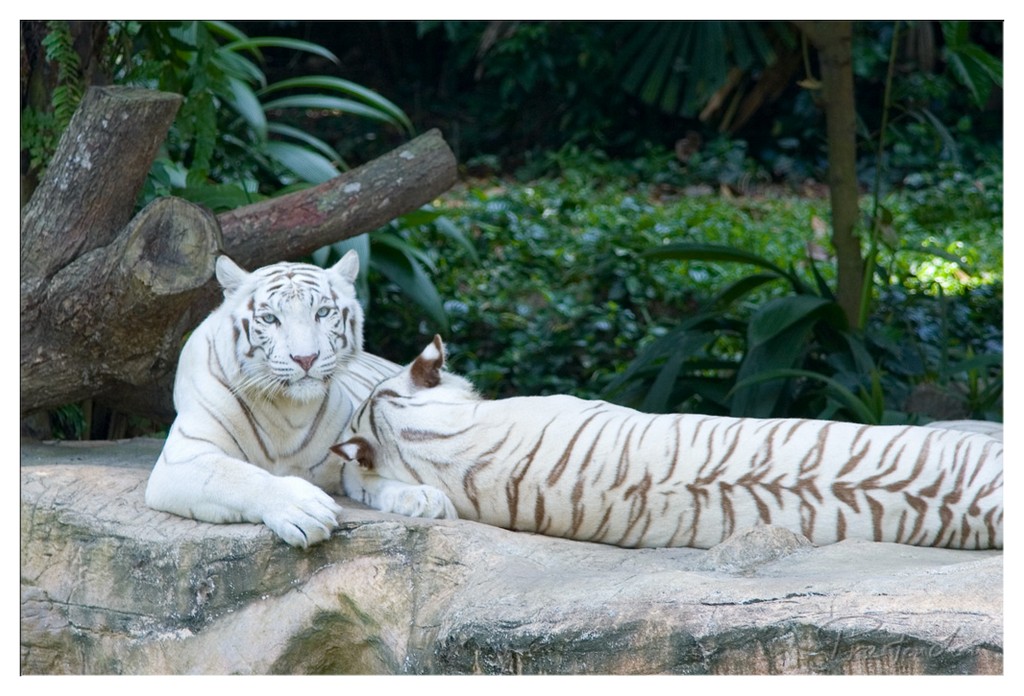

1. Overall Rating (0–10) — 7.5
This photograph captures a serene and majestic moment between two white tigers in a lush, naturalistic setting, where the contrast of their pale fur against the deep greens evokes a sense of quiet grandeur. The composition draws the viewer into a tranquil wildlife scene, though the slightly cluttered background and soft focus slightly diminish the image’s visual clarity. The emotional weight of the subjects’ calm presence is palpable, but the image could benefit from tighter framing and more intentional lighting to elevate its artistry.
2. Composition (0–10) — 7.0
The tigers are positioned diagonally across the frame, creating a dynamic visual flow from left to right. The foreground rock anchors the image, while the blurred foliage in the background provides depth, though the tree trunk on the left slightly distracts from the main subjects.
3. Lighting (0–10) — 7.5
Natural, diffused light softly illuminates the tigers, enhancing the texture of their fur without harsh shadows. The lighting feels authentic to a shaded, forested environment, contributing to the image’s peaceful mood.
4. Color & Tone (0–10) — 8.0
The cool, muted tones of the white fur contrast beautifully with the rich greens of the surrounding foliage. The warm brown of the stripes adds depth and visual interest, while the overall palette feels harmonious and natural.
5. Creativity (0–10) — 7.0
The image captures a rare and intimate moment between two animals, showcasing a quiet bond. While the subject matter is compelling, the execution leans more toward documentation than conceptual storytelling, with minimal artistic intervention.
6. Technical Quality (0–10) — 8.0
The image is sharp and clear, with fine detail visible in the tigers’ fur and the surrounding textures. Focus is well-placed on the animals, and the depth of field effectively isolates the subjects from the background.
7. Emotional Impact (0–10) — 8.0
The calm demeanor of the tigers and their close proximity evoke a sense of tenderness and companionship. The viewer is drawn into a moment of quiet intimacy, making the image emotionally resonant and memorable.
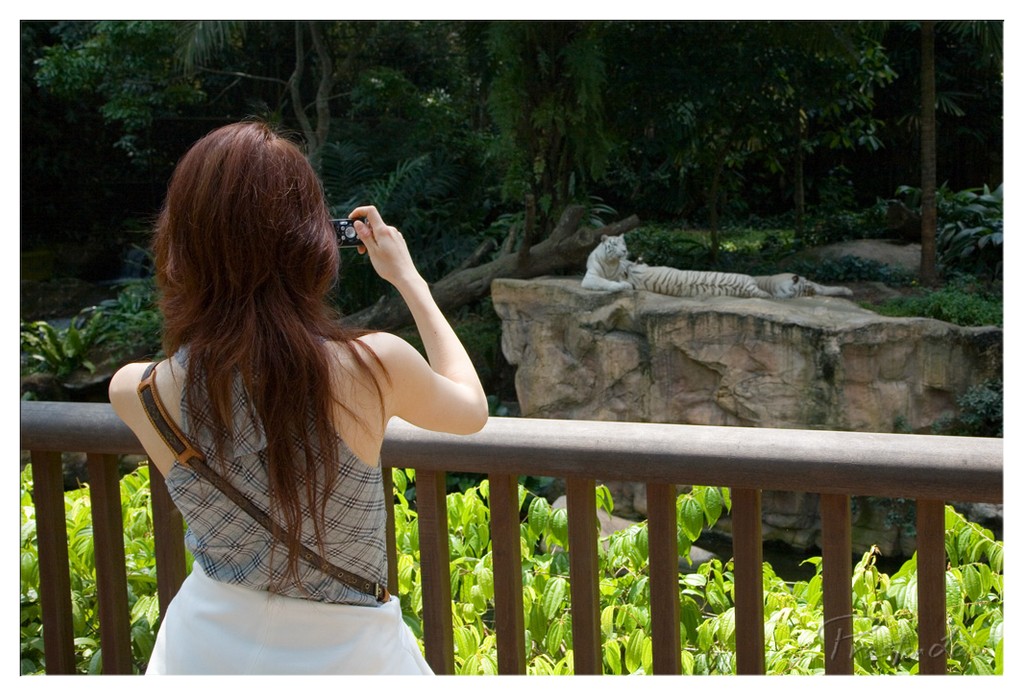

1. Overall Rating (0–10) — 7.0
This photograph captures a quiet, contemplative moment at a zoo, where the act of observation becomes a shared experience between human and animal. The juxtaposition of the woman photographing the white tiger creates a narrative of curiosity and wonder, enhanced by the lush, naturalistic setting. While the image is well-composed and emotionally resonant, its slightly flat lighting and lack of dynamic contrast temper its visual impact, preventing it from feeling fully immersive.
2. Composition (0–10) — 7.5
The woman is placed off-center, creating a natural leading line toward the white tiger, which rests prominently on the rock ledge. The railing frames the foreground, adding depth and grounding the viewer in the scene, though the composition feels slightly static due to the symmetrical placement of the subject and background elements.
3. Lighting (0–10) — 6.0
Natural daylight illuminates the scene evenly, but the light is somewhat flat, lacking strong directional quality or dramatic shadows. This results in a muted atmosphere, with the lush greenery appearing slightly washed out and the tiger’s white fur blending into the ambient light.
4. Color & Tone (0–10) — 6.5
The palette is dominated by soft greens and earthy tones, with the white tiger providing a subtle contrast. The colors are generally natural and cohesive, though the overall tone is slightly desaturated, reducing the vibrancy of the foliage and giving the image a calm, almost documentary-like feel.
5. Creativity (0–10) — 7.0
The image succeeds in capturing a quiet, introspective moment, blending human presence with wildlife in a way that suggests both wonder and distance. The narrative potential of the scene—of a visitor documenting a rare animal—adds a layer of storytelling that elevates the photograph beyond a simple snapshot.
6. Technical Quality (0–10) — 7.5
The image is sharp and well-focused, particularly on the woman and the tiger. The depth of field is appropriately managed, keeping both the foreground and background in clear view. The exposure is balanced, with no significant overexposed or underexposed areas.
7. Emotional Impact (0–10) — 6.5
There is a quiet emotional resonance in the scene—the woman’s focused gesture and the tiger’s relaxed repose evoke a sense of peaceful coexistence. However, the emotional connection is restrained by the image’s subdued lighting and lack of expressive detail, keeping the viewer in a reflective but detached position.
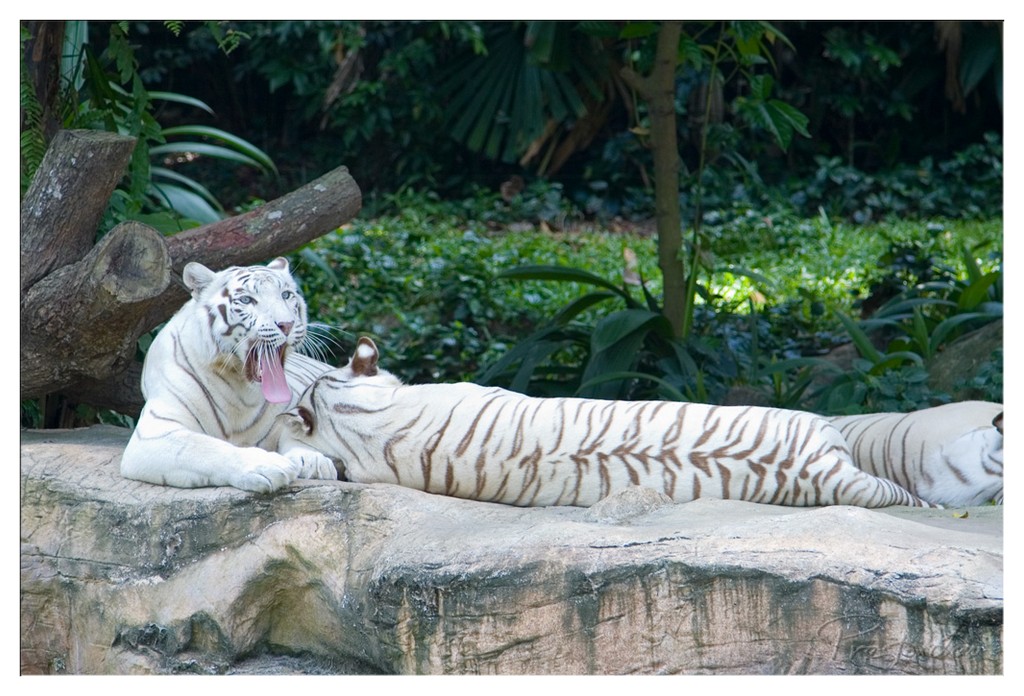

1. Overall Rating (0–10) — 7.0
This photograph captures a striking moment of two white tigers in a lush, naturalistic enclosure, where one yawns widely while the other rests peacefully. The contrast between the tigers’ pale fur and the rich green foliage creates a visually compelling scene, enhanced by the subtle interplay of light and shadow. While the image effectively conveys a sense of wildlife in repose, its potential is slightly diminished by a lack of dynamic tension and a somewhat passive composition.
2. Composition (0–10) — 6.5
The tigers are well-placed along the diagonal of the frame, creating a sense of movement and visual flow. However, the inclusion of the large log on the left slightly disrupts the balance, drawing attention away from the primary subjects.
3. Lighting (0–10) — 7.0
Natural light filters through the canopy, creating soft highlights on the tigers’ fur and subtle shadows that add depth. The lighting enhances the texture of the fur and the surrounding foliage, contributing to a calm and immersive atmosphere.
4. Color & Tone (0–10) — 7.5
The cool white of the tigers contrasts beautifully with the vibrant greens and earthy browns of the environment. The color palette is harmonious and natural, with a balanced tonal range that avoids oversaturation while maintaining visual interest.
5. Creativity (0–10) — 6.0
The moment captured—two tigers in quiet companionship—is inherently compelling, but the composition leans toward the observational rather than the narrative. A more deliberate framing or timing could have elevated the image into something more emotionally resonant.
6. Technical Quality (0–10) — 8.0
The image is sharp and detailed, with clear focus on the tigers’ faces and fur. The exposure is well-managed, and there are no significant artifacts or distortions, indicating strong technical execution.
7. Emotional Impact (0–10) — 6.5
The yawning tiger evokes a sense of vulnerability and intimacy, while the resting companion adds a layer of tranquility. The scene feels authentic and unposed, inviting viewers to reflect on the quiet dignity of these majestic animals.
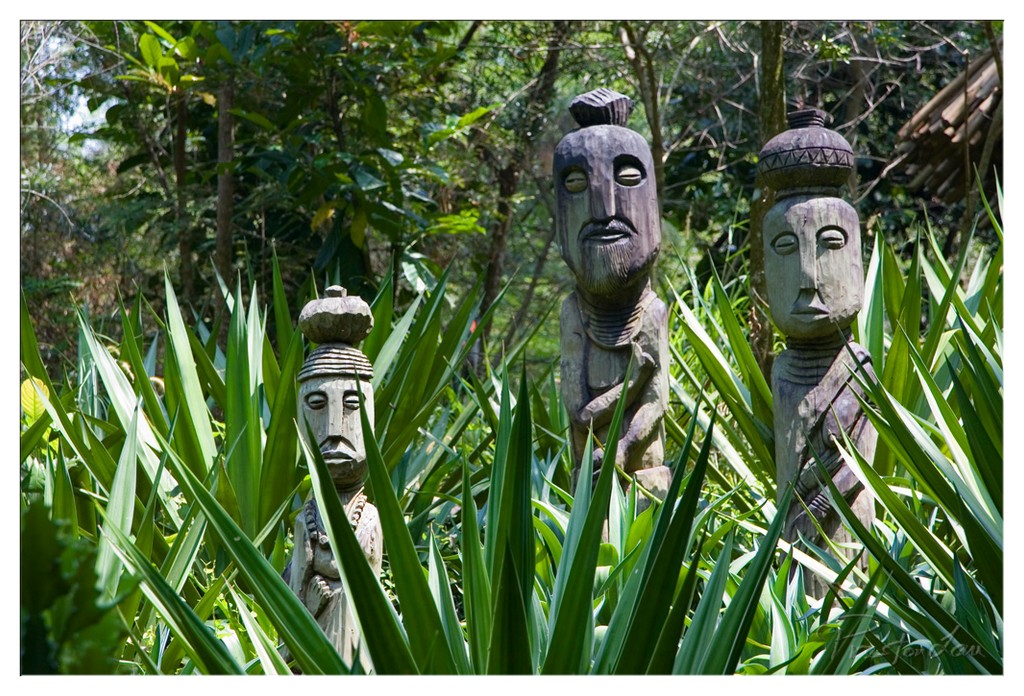

1. Overall Rating (0–10) — 7.0
This photograph captures a serene, almost mystical encounter between ancient woodcarvings and lush tropical foliage, where nature and art coexist in quiet harmony. The weathered textures of the statues and the vibrant greenery create a compelling contrast that speaks to time, culture, and the passage of seasons. While the image is rich in atmosphere, its full potential is slightly restrained by a lack of compositional focus and a somewhat flat lighting balance.
2. Composition (0–10) — 6.0
The statues are framed by blades of grass that partially obscure the lower portions, creating a sense of discovery but also distracting from the subjects. The central figure is slightly off-center, and the leftmost carving is cut off, disrupting visual balance.
3. Lighting (0–10) — 6.5
Natural daylight filters through the canopy, casting soft highlights and shadows that emphasize the textures of the wood. However, the lighting is uneven, with overexposed areas in the background and underexposed details in the shaded foreground.
4. Color & Tone (0–10) — 7.0
The dominant green of the foliage provides a strong, natural contrast to the muted gray-brown tones of the carvings, enhancing their presence. The saturation is natural and harmonious, though slightly muted, giving the scene a subdued, earthy tone.
5. Creativity (0–10) — 7.5
The juxtaposition of hand-carved figures within a wild, untamed garden offers a compelling narrative—suggesting themes of heritage, memory, and the reclaiming of art by nature. The framing invites curiosity and interpretation, lending the image a strong conceptual edge.
6. Technical Quality (0–10) — 7.5
The focus is sharp on the central statue, with clear detail in the carvings and foliage. The depth of field is well-managed, isolating the subject while maintaining context. There are no visible artifacts or noise, and the image is well-exposed overall.
7. Emotional Impact (0–10) — 7.0
The image evokes a sense of quiet reverence and timelessness, as if the viewer has stumbled upon a sacred, forgotten grove. The presence of the statues feels both solemn and welcoming, stirring a contemplative mood rooted in cultural resonance and natural beauty.
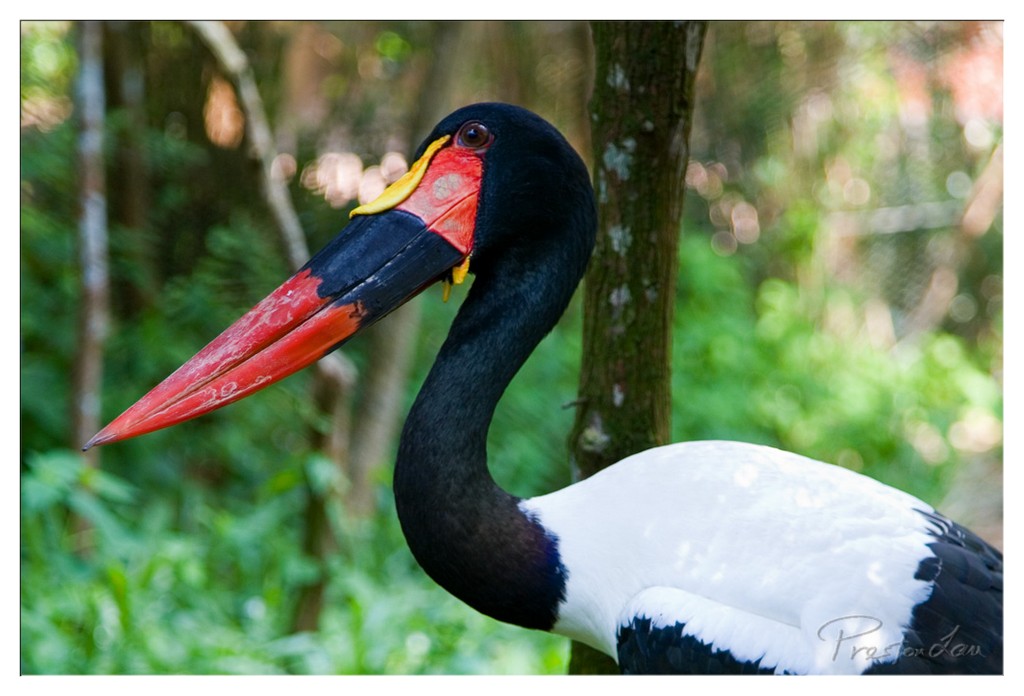

1. Overall Rating (0–10) — 8.0
This portrait of a saddle-billed stork captures the striking contrast of its bold plumage and vivid beak against a soft, verdant backdrop. The subject’s intense gaze and the rich saturation of its colors create a powerful visual presence, while the shallow depth of field isolates the bird with elegant precision. The image balances naturalism with artistic refinement, though a slightly more dynamic angle could elevate its narrative impact.
2. Composition (0–10) — 7.5
The stork is framed with strong visual emphasis, positioned slightly off-center to create a sense of movement. The tree trunk to the right adds structural balance, while the blurred foliage enhances focus on the bird’s profile. A tighter crop might further intensify the intimacy of the portrait.
3. Lighting (0–10) — 8.0
Natural, diffused light highlights the texture of the bird’s feathers and the glossy sheen of its beak, enhancing its three-dimensional form. The soft highlights and gentle shadows contribute to a lifelike, serene mood without harsh contrasts.
4. Color & Tone (0–10) — 8.5
The vibrant red and yellow of the beak pop against the deep black and white of the plumage, creating a striking, harmonious palette. The green bokeh background provides a natural contrast that enhances the subject’s prominence, while the tonal balance remains rich yet restrained.
5. Creativity (0–10) — 8.0
The photographer captures a moment of quiet intensity, transforming a wildlife portrait into a compelling character study. The choice to emphasize the stork’s profile and the use of selective focus lend a sense of narrative and elegance.
6. Technical Quality (0–10) — 8.5
Sharp focus on the bird’s eye and beak demonstrates excellent control, with clean detail and minimal noise. The depth of field is precisely managed, resulting in a crisp subject against a smoothly blurred background.
7. Emotional Impact (0–10) — 7.5
The stork’s direct gaze evokes a sense of quiet dignity and alertness, inviting the viewer into a moment of silent connection. The natural setting and composed stillness lend a contemplative, almost meditative quality to the image.
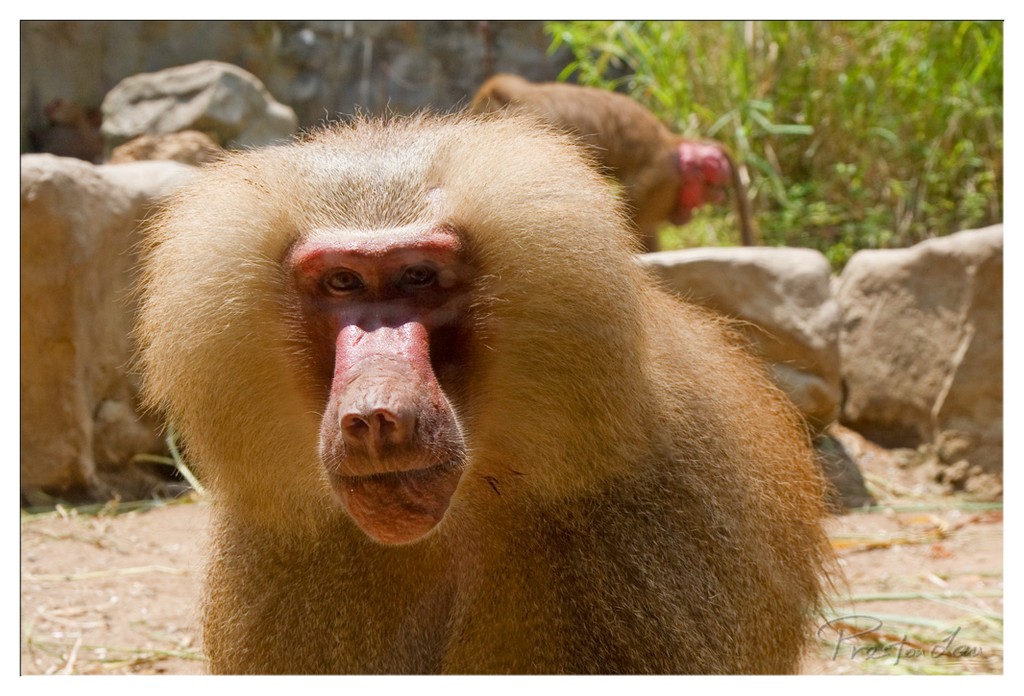

1. Overall Rating (0–10) — 7.5
This portrait of a baboon captures an intimate, almost human-like gaze that draws the viewer in, emphasizing the animal’s expressive features and textured fur. The shallow depth of field isolates the subject beautifully, while the natural lighting enhances the warmth and realism of the moment. While the image is compelling and well-executed, its emotional resonance is slightly tempered by the background’s faint distractions, keeping it from achieving full visual harmony.
2. Composition (0–10) — 7.0
The subject is centered and fills the frame, creating a strong focal point. The use of shallow depth of field effectively blurs the background, though the secondary baboon and scattered foliage create minor visual clutter on the right.
3. Lighting (0–10) — 8.0
Natural sunlight illuminates the subject evenly, highlighting the texture of the fur and the smoothness of the facial skin. The soft shadows under the jaw and forehead add dimension without creating harshness.
4. Color & Tone (0–10) — 7.5
The warm, earthy tones of the fur harmonize with the surrounding environment, while the red of the baboon’s face provides a striking focal point. The color balance feels natural and enhances the organic quality of the scene.
5. Creativity (0–10) — 8.0
The photographer captures a moment of quiet intensity, transforming a simple animal portrait into a contemplative study of expression. The close-up perspective and shallow focus lend a sense of intimacy and narrative.
6. Technical Quality (0–10) — 8.5
The image is sharp on the subject’s face, with excellent focus and clarity. The depth of field is controlled precisely, and the exposure is well-balanced, with no noticeable noise or loss of detail.
7. Emotional Impact (0–10) — 8.0
The baboon’s direct gaze evokes a sense of connection and curiosity, inviting the viewer to consider the animal’s inner life. There’s a subtle vulnerability in its expression that resonates emotionally, making the image memorable.
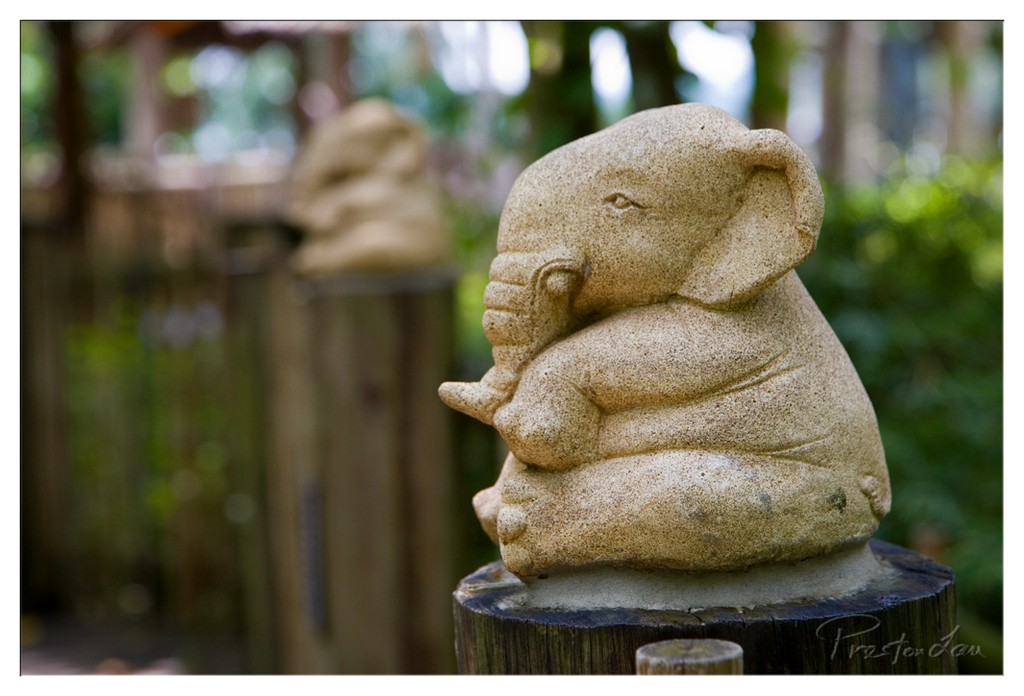

1. Overall Rating (0–10) — 7.0
This photograph captures a serene, contemplative moment with a stone elephant sculpture, its gentle pose evoking a sense of calm and introspection. The soft focus on the background enhances the subject’s quiet presence, while the natural textures of stone and wood lend a tactile, grounded quality. While the image is visually pleasing and well-composed, it feels slightly restrained in emotional depth, holding back from fully immersive storytelling.
2. Composition (0–10) — 7.5
The elephant is placed slightly off-center, creating a balanced and natural feel, with the second sculpture in the background adding depth. The use of leading lines from the wooden post and foliage draws the eye toward the main subject, though the background could be slightly more refined to avoid visual clutter.
3. Lighting (0–10) — 7.0
Soft, diffused natural light enhances the texture of the stone without creating harsh shadows. The gentle illumination highlights the contours of the elephant, contributing to the tranquil mood, though the overall exposure is slightly muted, giving the image a subdued tone.
4. Color & Tone (0–10) — 7.5
The palette is harmonious, with earthy beiges and warm browns complementing the lush greens of the background. The tonal range is balanced, with subtle contrast that emphasizes texture without overwhelming the scene.
5. Creativity (0–10) — 7.0
The choice of a meditative elephant sculpture as a focal point is thoughtful and symbolic, evoking themes of wisdom and peace. The shallow depth of field enhances the artistic quality, though the concept remains familiar rather than groundbreaking.
6. Technical Quality (0–10) — 8.0
Sharp focus on the elephant’s face and body, with a smooth bokeh in the background, demonstrates strong technical control. The image is clear, well-exposed, and free of distracting flaws.
7. Emotional Impact (0–10) — 7.0
The photograph evokes a quiet sense of peace and reflection, inviting the viewer to pause and appreciate stillness. While the emotional resonance is gentle, it is sincere and effective in creating a moment of calm.
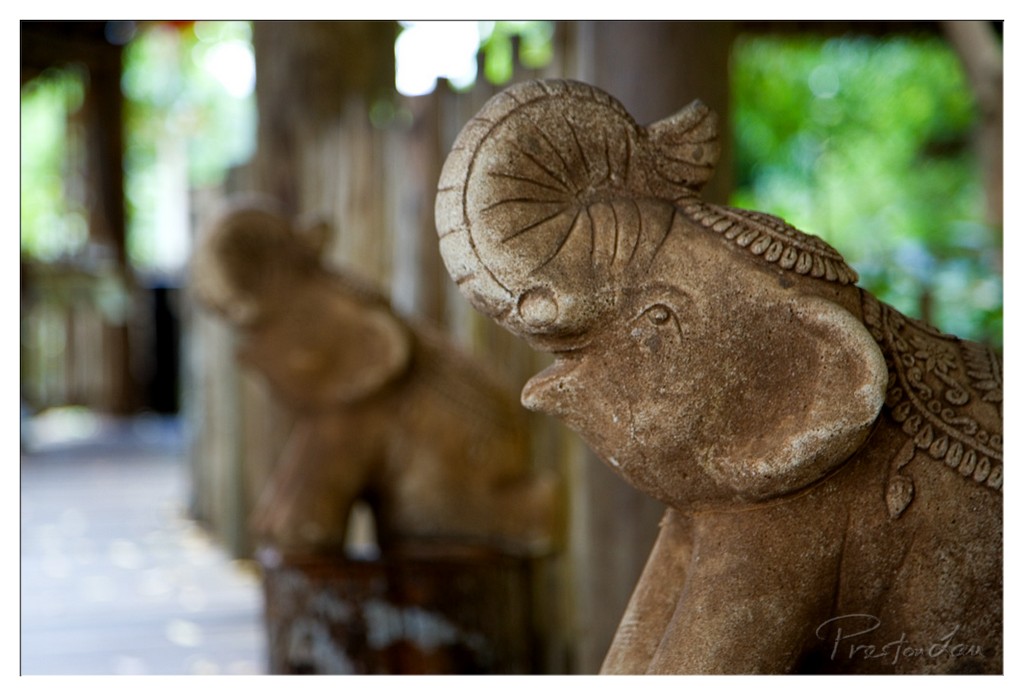

1. Overall Rating (0–10) — 7.5
This photograph captures the quiet dignity of two stone elephant sculptures, their weathered surfaces telling stories of time and tradition. The shallow depth of field draws the eye to the rich texture and intricate carvings of the foreground figure, while the soft, sun-dappled background evokes a serene, temple-like atmosphere. While the image is visually compelling and rich in detail, a slightly warmer color cast might deepen its emotional resonance and cultural warmth.
2. Composition (0–10) — 7.0
The diagonal arrangement of the elephants creates a natural leading line, guiding the viewer’s gaze from the blurred background to the sharply focused foreground. The use of negative space and off-center placement enhances the sense of depth and narrative, though the left edge feels slightly unbalanced due to the asymmetrical framing.
3. Lighting (0–10) — 7.5
Soft, diffused natural light filters through the trees, gently illuminating the sculptures and highlighting their textures without harsh shadows. The dappled sunlight adds a dreamy, contemplative quality, enhancing the spiritual and timeless mood of the scene.
4. Color & Tone (0–10) — 7.0
The palette consists of earthy browns and muted greens, lending a natural, organic feel. The tonal contrast between the warm stone and the cool green backdrop creates visual harmony, though the colors could benefit from slightly increased saturation to enhance vibrancy.
5. Creativity (0–10) — 8.0
The photographer’s choice to emphasize texture and depth through selective focus transforms a simple scene into a meditative portrait of cultural artistry. The subtle interplay between the sculptures and their environment suggests a quiet reverence, elevating the image beyond mere documentation.
6. Technical Quality (0–10) — 8.5
Sharp focus on the foreground elephant reveals fine details in the carving, while the background remains smoothly blurred. The exposure is well-balanced, and the lens flare or light spots add a natural, atmospheric effect without detracting from clarity.
7. Emotional Impact (0–10) — 8.0
The image evokes a sense of peace, reverence, and timelessness, inviting the viewer to pause and reflect. The quiet presence of the elephants, combined with the soft light and serene setting, creates a deeply contemplative and emotionally resonant moment.
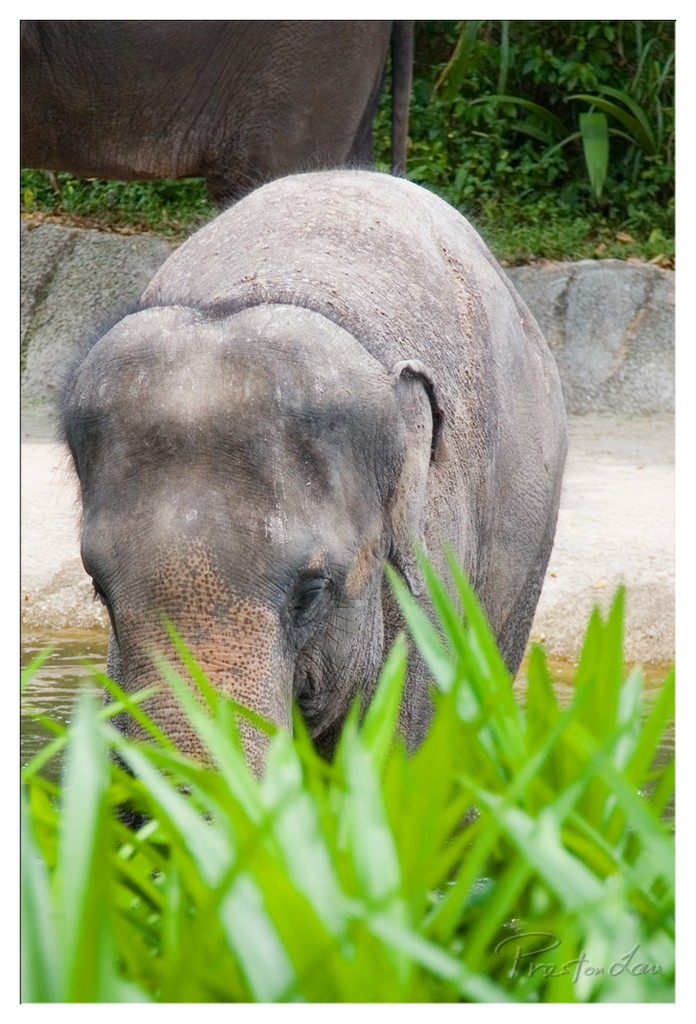

1. Overall Rating (0–10) — 7.0
This photograph captures a serene moment of an elephant in a naturalistic setting, where the interplay of texture and depth creates a compelling visual narrative. The lush greenery in the foreground contrasts beautifully with the elephant’s wrinkled, earth-toned skin, lending the image a sense of intimacy and quiet dignity. While the composition is strong and the subject is engaging, the slightly awkward framing and soft focus on the background reduce its overall impact, preventing it from achieving a truly immersive quality.
2. Composition (0–10) — 6.5
The elephant is centered but partially obscured by foreground foliage, creating depth and a sense of discovery. However, the overgrowth slightly disrupts the visual flow, and the second elephant in the background feels underutilized, adding clutter without narrative purpose.
3. Lighting (0–10) — 6.0
Natural daylight illuminates the scene evenly, with soft shadows that enhance the elephant’s textured skin. The lighting is functional but lacks dramatic contrast, resulting in a flatness that diminishes the potential for mood.
4. Color & Tone (0–10) — 7.5
The rich, saturated greens of the foliage create a vibrant contrast against the muted grays and browns of the elephant, enhancing visual interest. The tonal range is balanced, with the warm tones of the skin adding warmth and grounding the image.
5. Creativity (0–10) — 6.5
The use of foreground elements to frame the subject adds a layer of visual storytelling, suggesting a hidden moment observed from a distance. While not radically original, the approach feels thoughtful and grounded in a naturalistic perspective.
6. Technical Quality (0–10) — 7.0
The focus is sharp on the elephant’s head, with a clear depth of field that blurs the background effectively. The image is clean, with no visible noise or artifacts, demonstrating solid technical execution.
7. Emotional Impact (0–10) — 7.0
The gentle posture and calm expression of the elephant evoke a sense of peace and quiet contemplation. The viewer is drawn into a moment of stillness, fostering a connection with the animal’s presence, even if the emotional resonance is slightly muted by the framing.
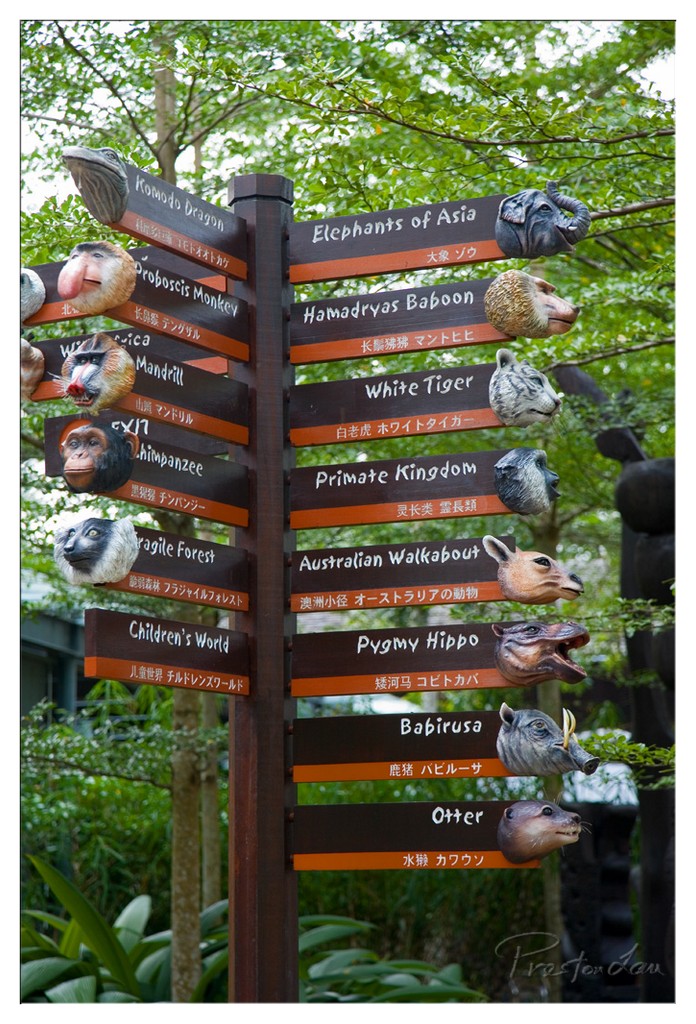

1. Overall Rating (0–10) — 7.0
This photograph captures a whimsical and informative zoo directional signpost, where each arrow points to an animal exhibit, crowned with sculpted heads of the respective species. The playful integration of animal forms with signage creates a lively, child-friendly atmosphere that feels both educational and imaginative. While the image successfully conveys the theme of a zoo adventure, the overcast lighting and slight lack of focus detract from the vibrancy of the scene.
2. Composition (0–10) — 7.0
The vertical arrangement of the signs creates a strong central axis, drawing the eye upward through the layers of information. The inclusion of foliage at the top and bottom frames the subject, adding depth and context. The slight tilt of the pole adds a subtle dynamic quality, though the composition is mostly balanced and clear.
3. Lighting (0–10) — 6.0
Soft, diffused lighting from an overcast sky provides even exposure across the scene, minimizing harsh shadows. However, this also results in muted tones and a lack of contrast, which slightly dampens the visual energy of the colorful signs.
4. Color & Tone (0–10) — 7.0
The warm brown tones of the signposts and the rich, earthy colors of the animal sculptures create a cohesive palette. The green foliage provides a natural backdrop that enhances the organic theme. While the colors are pleasant, they lack saturation, giving the image a slightly flat appearance.
5. Creativity (0–10) — 8.0
The creative use of animal sculptures as directional markers is imaginative and engaging, transforming a functional object into an artistic element. The bilingual text adds cultural depth and broadens accessibility, reinforcing the theme of global wildlife.
6. Technical Quality (0–10) — 7.0
The image is sharp and in focus, with clear legibility of the text and sculptural details. The depth of field is appropriate, keeping the signpost in crisp detail while softly blurring the background. The watermark in the lower right corner is subtle and does not distract.
7. Emotional Impact (0–10) — 6.5
The photograph evokes a sense of wonder and curiosity, especially for viewers familiar with zoos and animal exhibits. The playful design suggests a joyful, educational experience, though the subdued lighting limits the emotional warmth and excitement of the moment.
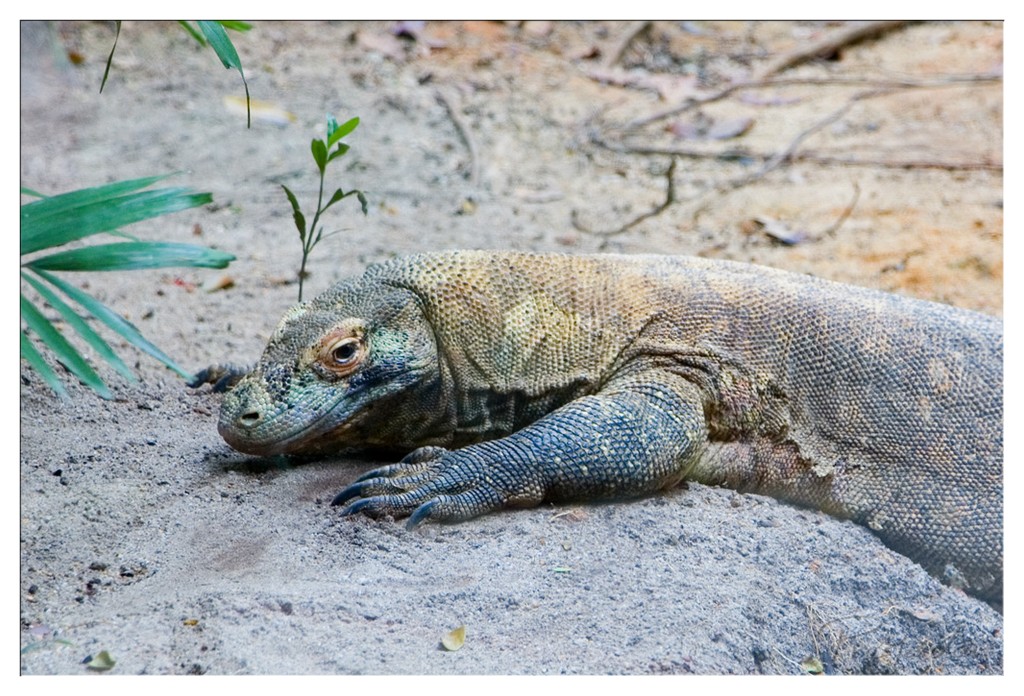

1. Overall Rating (0–10) — 7.0
This photograph captures the imposing presence of a Komodo dragon in a naturalistic setting, where the creature’s textured skin and calm demeanor evoke a sense of ancient stillness. The tight framing emphasizes the reptile’s powerful form and intricate details, while the soft, natural light enhances the tactile quality of its scales. Though the background remains somewhat indistinct, the image successfully conveys a quiet moment of wildlife observation, balancing documentary clarity with subtle artistry.
2. Composition (0–10) — 7.5
The Komodo dragon is positioned diagonally across the frame, creating a dynamic visual path that guides the eye from the foreground to the subject’s head. The inclusion of green foliage on the left adds balance and contextual depth, while the shallow depth of field isolates the subject effectively.
3. Lighting (0–10) — 7.0
Soft, diffused daylight illuminates the scene evenly, highlighting the texture of the dragon’s skin without harsh shadows. The lighting enhances the natural tones of the environment and contributes to the image’s calm, observational mood.
4. Color & Tone (0–10) — 7.5
The palette blends earthy browns, muted greens, and subtle grays, creating a harmonious and naturalistic tone. The contrast between the reptile’s dark scales and the lighter sand grounds the subject while maintaining visual cohesion.
5. Creativity (0–10) — 7.0
The image presents a familiar subject with a focus on texture and quiet presence, avoiding dramatic staging in favor of authenticity. The perspective invites contemplation of the creature’s ancient lineage and ecological role.
6. Technical Quality (0–10) — 8.0
The focus is sharp on the dragon’s head and front limbs, with excellent detail in the scales and claws. The exposure is well-balanced, and the image is free of distracting artifacts.
7. Emotional Impact (0–10) — 7.0
The photograph evokes a sense of awe and respect for the Komodo dragon as a living relic of prehistoric life. Its calm posture and direct gaze create a subtle connection with the viewer, fostering a moment of quiet contemplation.
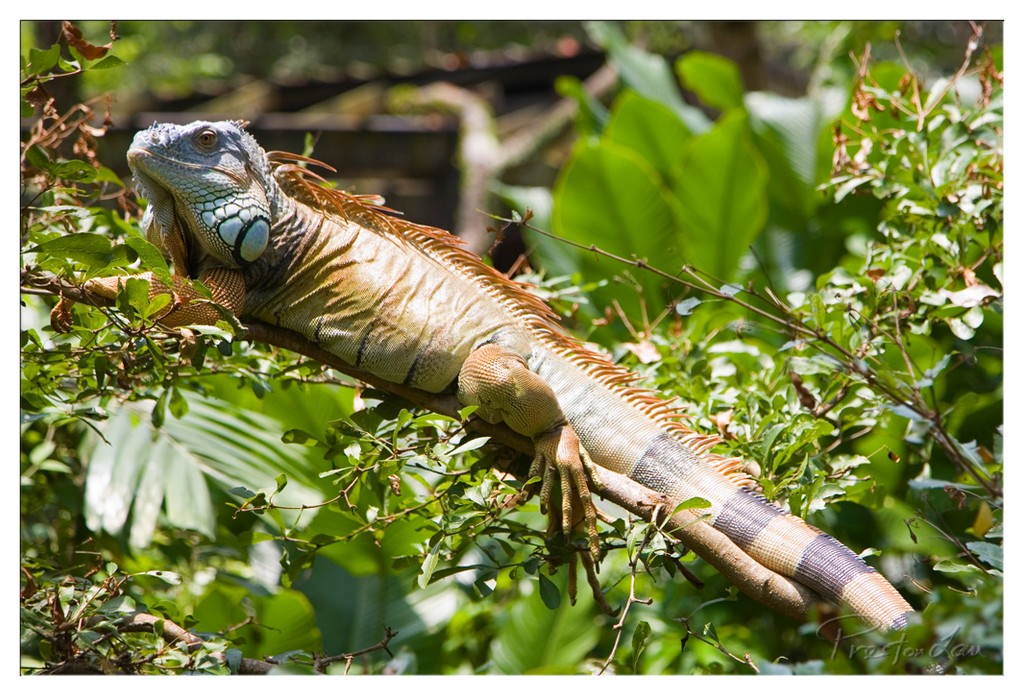

1. Overall Rating (0–10) — 8.0
This photograph captures the regal presence of an iguana in its natural habitat with striking clarity and vibrant detail. The subject is framed dynamically, its elongated body leading the eye through the lush greenery, while the soft bokeh background enhances focus on the creature’s textured scales and vivid coloration. Though the lighting is slightly harsh, the image succeeds in conveying both the biological beauty and quiet majesty of the animal, making it a compelling blend of wildlife documentation and artistic expression.
2. Composition (0–10) — 8.0
The iguana is positioned diagonally across the frame, creating a sense of movement and natural flow. The use of leading lines from the branch and surrounding foliage guides the viewer’s gaze effectively, while the depth of field isolates the subject without cutting off its body, maintaining balance and visual harmony.
3. Lighting (0–10) — 7.0
Bright, direct sunlight highlights the iguana’s intricate scale patterns and vibrant orange and blue markings, but creates some overexposed areas in the background. The light enhances texture and detail, though the contrast between shadow and highlight slightly flattens the image’s tonal range.
4. Color & Tone (0–10) — 8.5
The palette is rich and natural, with lush greens complementing the iguana’s earthy tones and striking blue accents. The contrast between the warm orange of the crest and the cool green of the foliage adds visual energy, while the overall tone remains cohesive and vibrant.
5. Creativity (0–10) — 7.5
The image captures a moment of serene wildlife observation with a strong sense of presence. While the subject is common in tropical settings, the tight framing and attention to detail elevate it beyond a simple snapshot into a portrait that emphasizes the animal’s unique character.
6. Technical Quality (0–10) — 9.0
The image is sharp and well-focused, with excellent detail in the iguana’s skin and surrounding leaves. The shallow depth of field is well-executed, and the exposure is generally balanced, with only minor issues in highlights.
7. Emotional Impact (0–10) — 7.0
The photograph evokes a sense of calm and wonder, inviting the viewer to appreciate the quiet dignity of a creature often overlooked. The intimacy of the close-up and the animal’s stillness create a moment of connection, though the lack of human context or narrative slightly limits deeper emotional resonance.
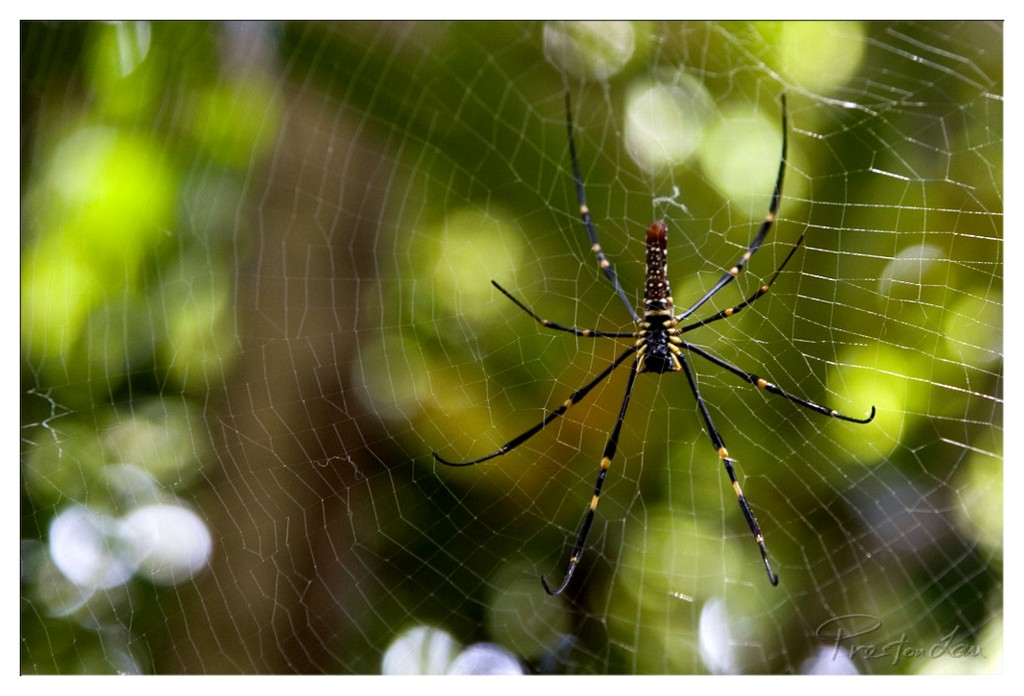

1. Overall Rating (0–10) — 7.5
This photograph captures the delicate precision of a spider at the center of its web, surrounded by a lush, dreamlike forest backdrop. The interplay of light and texture brings the intricate details of the web and the spider’s striking markings into vivid focus, creating a moment of quiet natural drama. While the image is technically strong, the composition’s slight imbalance and overemphasis on bokeh slightly diminish its overall cohesion.
2. Composition (0–10) — 6.5
The spider is placed slightly off-center, drawing the eye naturally, but the dense web lines and scattered bokeh create a visually busy frame. A more deliberate crop could enhance focus and symmetry.
3. Lighting (0–10) — 8.0
Soft, diffused light highlights the spider’s body and web threads with clarity, enhancing texture without harsh shadows. The backlighting gently outlines the spider, adding depth and dimension.
4. Color & Tone (0–10) — 7.0
The vibrant greens of the background contrast beautifully with the black and yellow of the spider, creating a natural palette that feels both rich and balanced. The bokeh adds soft white and pale green highlights that enhance the dreamy atmosphere.
5. Creativity (0–10) — 8.0
The photographer captures a moment of quiet intensity in the natural world, transforming a common subject into something majestic. The use of shallow depth of field and natural lighting elevates the image beyond mere documentation.
6. Technical Quality (0–10) — 8.5
Sharp focus on the spider, clean details in the web, and excellent control of depth of field demonstrate strong technical execution. The image is crisp and well-exposed.
7. Emotional Impact (0–10) — 7.5
The image evokes a sense of wonder and quiet reverence for the intricacy of nature. The viewer is drawn into the spider’s world, feeling both awe and a subtle unease—familiar yet alien, beautiful yet unsettling.
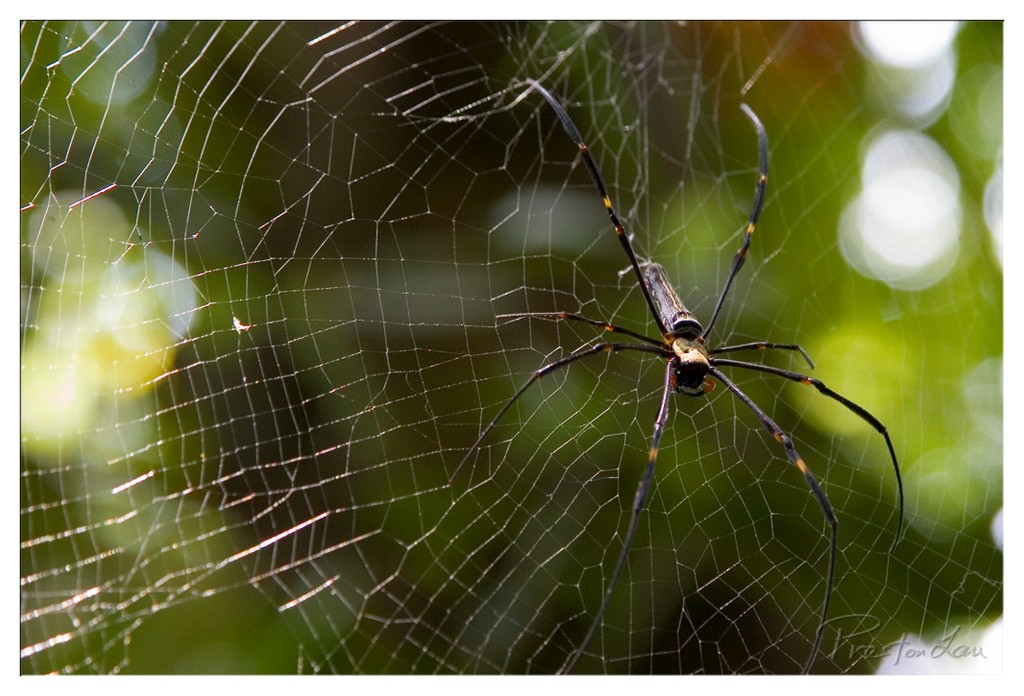

1. Overall Rating (0–10) — 7.5
This image captures the delicate intricacy of a spider’s web with striking clarity, transforming a fleeting natural moment into a visually arresting composition. The interplay of light on the silk strands and the poised presence of the spider evoke both fragility and mastery. While the soft focus in the background enhances the subject, the composition could be more dynamic with tighter framing to emphasize the spider’s dominance.
2. Composition (0–10) — 7.0
The spider is placed slightly off-center, creating a natural focal point, while the radial symmetry of the web adds visual harmony. The diagonal lines of the legs draw the eye across the frame, though the wide border of web and background slightly dilutes the impact.
3. Lighting (0–10) — 8.0
Soft, diffused backlighting highlights the fine threads of the web, creating a luminous, almost ethereal glow. The gentle illumination enhances texture and depth, while the bokeh in the background adds a dreamlike quality.
4. Color & Tone (0–10) — 7.5
The rich, saturated greens of the background contrast beautifully with the dark, slender form of the spider, creating a natural palette that feels both organic and balanced. The warm highlights on the silk add a subtle golden tone, enhancing the image’s visual warmth.
5. Creativity (0–10) — 8.0
The photographer captures a moment of quiet elegance in nature, elevating the mundane into something poetic. The choice to emphasize the web’s architecture and the spider’s poised stance reflects a thoughtful, almost reverent approach to macro storytelling.
6. Technical Quality (0–10) — 8.5
Exceptionally sharp focus on the spider and web, with minimal noise and precise depth of field. The clean background and crisp detail in the silk indicate strong technical execution.
7. Emotional Impact (0–10) — 7.0
The image evokes a sense of awe at the precision of nature, stirring quiet contemplation. The stillness of the spider and the fragile beauty of the web invite the viewer to pause and reflect on the unseen intricacies of the natural world.
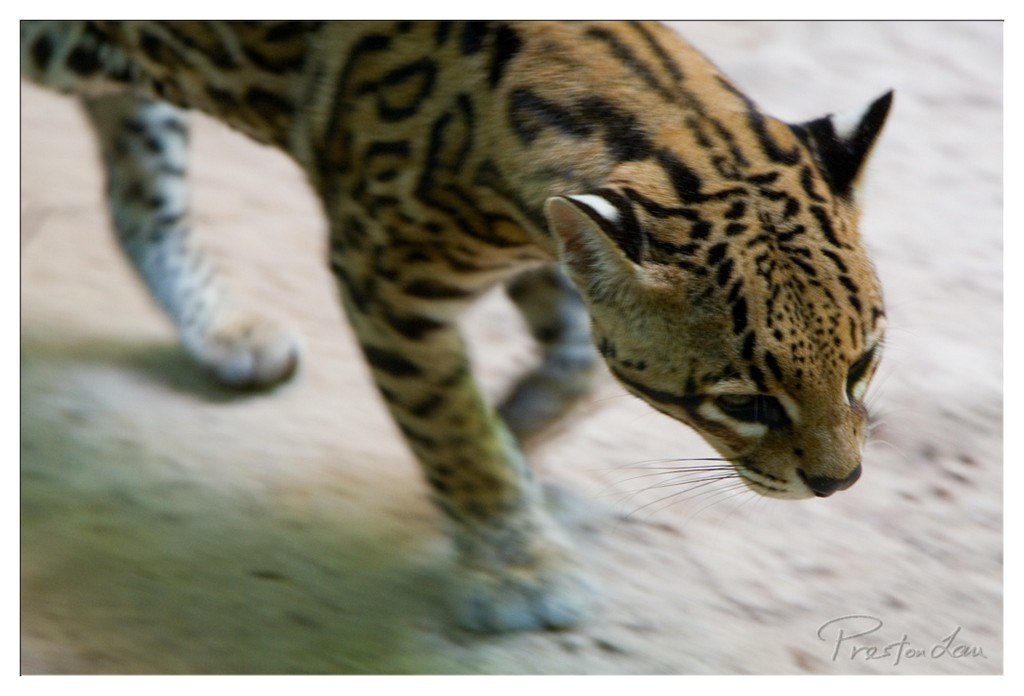

1. Overall Rating (0–10) — 7.0
This photograph captures the quiet intensity of an ocelot in motion, its predatory grace frozen in a moment of focused intent. The shallow depth of field isolates the animal’s face, drawing the viewer into its world with a sense of immediacy and intimacy. While the image excels in mood and subject engagement, a slightly more deliberate composition and richer tonal contrast could elevate its artistic impact.
2. Composition (0–10) — 6.5
The ocelot is placed diagonally across the frame, creating a dynamic sense of movement. However, the left side of the image feels underdeveloped, with the subject's body trailing into a blur that risks losing narrative cohesion. A tighter crop or more balanced framing would enhance visual unity.
3. Lighting (0–10) — 6.0
Soft, diffused lighting evenly illuminates the ocelot’s face, preserving fine detail in its fur without harsh shadows. The light, while functional, lacks dramatic contrast, giving the scene a neutral, almost clinical quality that slightly undermines the animal’s wild presence.
4. Color & Tone (0–10) — 6.5
The warm beige and black tones of the ocelot’s coat are rendered naturally, with a muted, earthy palette that complements the animal’s camouflage. The background’s pale, desaturated green adds subtle depth, though the overall tonal range is restrained, limiting visual richness.
5. Creativity (0–10) — 7.5
The choice to capture the ocelot in motion with a shallow depth of field is both bold and effective, emphasizing the creature’s focus and instinct. The image tells a quiet story of survival and elegance, elevating it beyond a simple wildlife snapshot into a moment of contemplative observation.
6. Technical Quality (0–10) — 8.0
The focus is sharp on the ocelot’s face, with fine detail visible in the fur and whiskers. The image is free from noise and blur, with clean handling of motion and depth of field, demonstrating strong technical control.
7. Emotional Impact (0–10) — 7.0
There’s a palpable tension in the ocelot’s lowered head and focused gaze, evoking a sense of anticipation and primal awareness. The viewer is drawn into the animal’s perspective, creating a moment of connection that feels both intimate and fleeting.
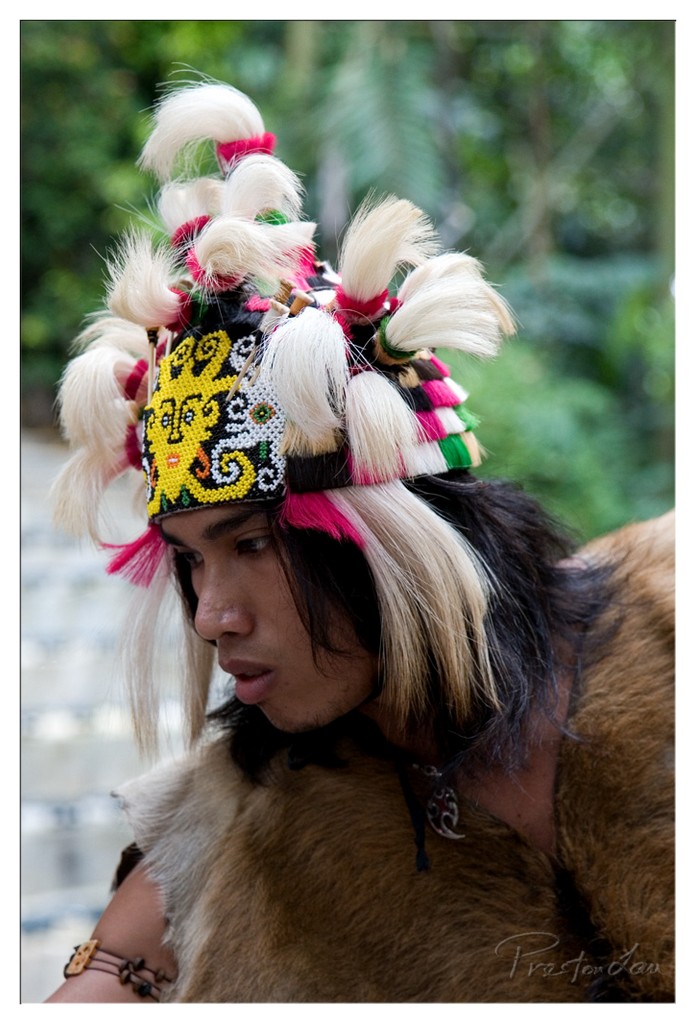

1. Overall Rating (0–10) — 7.5
This portrait captures the dignified presence of a person adorned in elaborate traditional regalia, where cultural identity is expressed through intricate craftsmanship and vibrant symbolism. The rich textures of the beaded headdress and fur vest stand out against the soft, blurred green backdrop, drawing the viewer into a moment of quiet reverence. While the image succeeds in highlighting cultural heritage, its emotional resonance is slightly restrained by the subject’s neutral expression and the modest lighting.
2. Composition (0–10) — 7.0
The subject is framed off-center, creating a dynamic balance that guides the eye toward the intricate details of the headdress. The shallow depth of field isolates the figure effectively, though the composition feels slightly cropped, cutting into the shoulder and neck area, which slightly disrupts the sense of full presence.
3. Lighting (0–10) — 6.5
Natural, diffused light softly illuminates the subject from the front, preserving the details of the beaded patterns and feathered adornments. The light is even but lacks directional warmth, resulting in a slightly flat quality that diminishes the sense of depth and dimensionality.
4. Color & Tone (0–10) — 8.0
The palette is rich and vibrant, with bold yellows, pinks, and greens in the headdress contrasting beautifully against the earthy brown of the fur and the soft green background. The colors are well-saturated and harmonious, enhancing the cultural richness of the subject.
5. Creativity (0–10) — 8.0
The image demonstrates strong cultural storytelling through the deliberate choice of subject and costume. The focus on traditional elements—beadwork, feathers, and natural materials—elevates the photograph beyond a simple portrait into a celebration of identity and heritage. The composition and color choices reflect a thoughtful artistic vision.
6. Technical Quality (0–10) — 8.0
Sharp focus is maintained on the face and headdress, allowing for fine detail in the beading and texture of the fur. The depth of field is well-managed, and the image is free of noise or blur, indicating strong technical execution.
7. Emotional Impact (0–10) — 7.0
The image evokes a sense of respect and quiet pride, with the subject’s contemplative gaze inviting reflection on tradition and belonging. While the emotional connection is strong, it is subtle and understated, relying on cultural significance rather than overt expression.
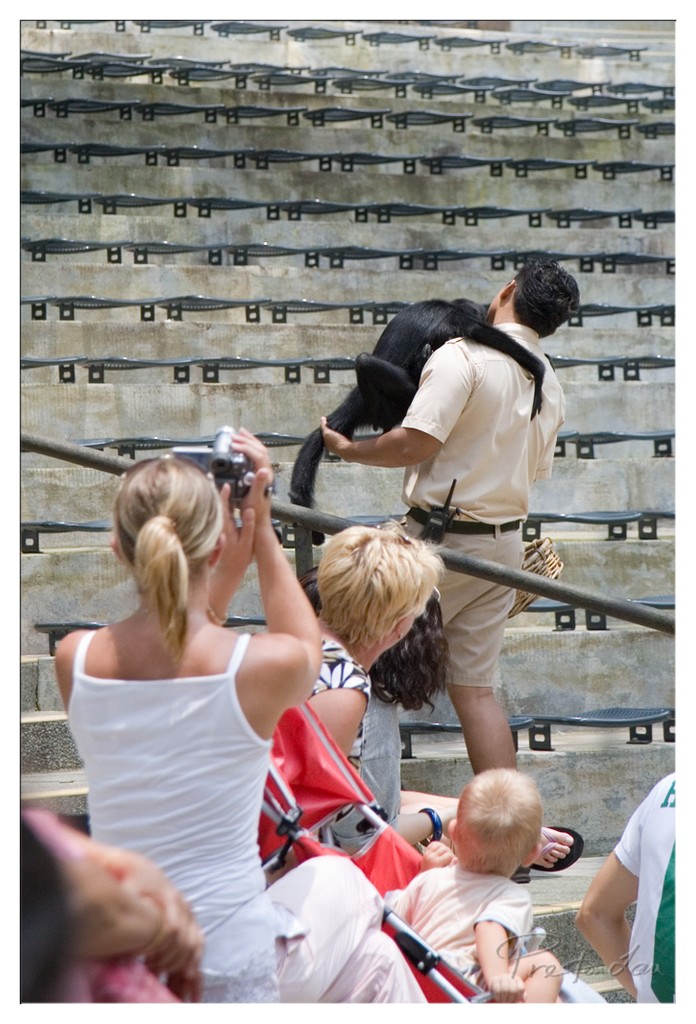

1. Overall Rating (0–10) — 6.0
This photograph captures a candid, lively moment at what appears to be a zoo or wildlife demonstration, where a handler carries a black monkey across rows of empty bleachers. The scene feels authentic and spontaneous, with the audience’s engagement—especially the woman photographing the moment—adding a layer of voyeuristic charm. However, the composition is slightly chaotic, and the lighting lacks dramatic depth, which keeps the image from feeling truly striking. It succeeds as a snapshot of human-animal interaction but falls short of visual elegance.
2. Composition (0–10) — 5.5
The diagonal lines of the empty seats create a strong visual structure, but the framing feels crowded and unbalanced. The foreground subjects, including the woman with the camera and the baby, partially obstruct the view of the handler and monkey, disrupting the narrative flow.
3. Lighting (0–10) — 5.0
The scene is lit with bright, direct daylight, which flattens shadows and reduces depth. While the light is even and functional, it lacks the warmth or contrast that would enhance mood or texture.
4. Color & Tone (0–10) — 5.5
The color palette is muted and natural, dominated by beige, black, and pale skin tones. There is little vibrancy, and the overall tone feels slightly washed out, diminishing the visual impact of the monkey’s dark fur and the bright white tank top.
5. Creativity (0–10) — 6.5
The juxtaposition of the handler, the monkey, and the audience creates a narrative that’s both curious and slightly surreal. The image captures a fleeting, real-world interaction, but the lack of deliberate staging or artistic control keeps it from feeling particularly original.
6. Technical Quality (0–10) — 7.0
The focus is sharp on the central subjects, and the image is clear with minimal noise. However, the wide-angle perspective introduces some distortion and clutter, which detracts from the overall technical polish.
7. Emotional Impact (0–10) — 5.5
The image evokes a sense of curiosity and mild amusement, particularly through the audience’s reactions. Yet, the emotional resonance is limited by the distance created by the framing and the impersonal setting of the bleachers, leaving the viewer as a passive observer rather than an engaged participant.
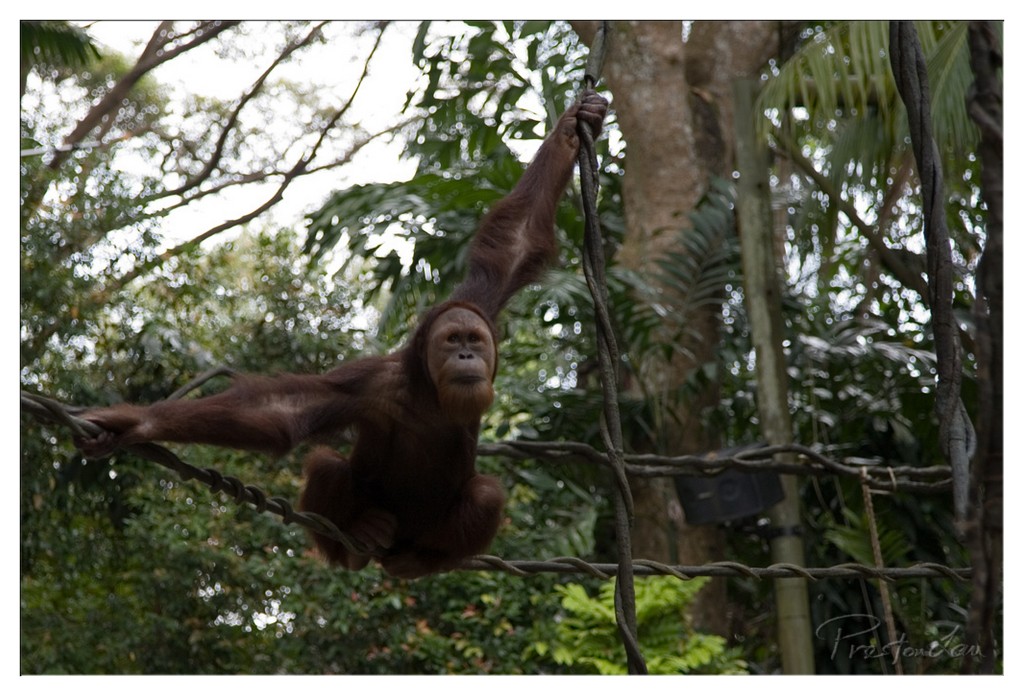

1. Overall Rating (0–10) — 7.0
This photograph captures a moment of quiet strength and natural grace, as an orangutan navigates a rope structure amid lush greenery. The subject’s calm gaze and poised movement convey a sense of intelligence and serenity, while the soft, diffused lighting enhances the wild yet contemplative mood. While the image is compelling, the slightly muted colors and soft focus reduce its visual punch, keeping it from fully resonating as a powerful wildlife portrait.
2. Composition (0–10) — 7.0
The orangutan is well-centered, with its body forming a dynamic diagonal that draws the eye across the frame. The intertwining ropes add texture and depth, while the blurred foliage creates a natural backdrop that keeps focus on the subject.
3. Lighting (0–10) — 6.5
Soft, diffused light filters through the canopy, creating a gentle glow that avoids harsh shadows. While the lighting is natural and appropriate for the setting, it lacks dramatic contrast, resulting in a somewhat flat overall impression.
4. Color & Tone (0–10) — 6.0
The warm brown tones of the orangutan’s fur contrast subtly with the greens of the foliage, but the overall palette feels subdued. A touch more saturation and contrast would enhance the vibrancy of the scene.
5. Creativity (0–10) — 7.0
The image successfully captures a candid, intimate moment in the life of an orangutan, blending wildlife observation with artistic framing. The choice to include the rope structure adds a subtle narrative layer, suggesting a space where nature and human intervention intersect.
6. Technical Quality (0–10) — 7.5
The focus is sharp on the orangutan’s face and torso, while the background remains softly blurred, demonstrating effective depth of field. The image is clean, with minimal noise and good resolution.
7. Emotional Impact (0–10) — 7.5
The orangutan’s calm expression and poised posture evoke a sense of empathy and connection, inviting the viewer to reflect on its intelligence and the fragility of its natural habitat. The image lingers emotionally, even if its technical brilliance is restrained.
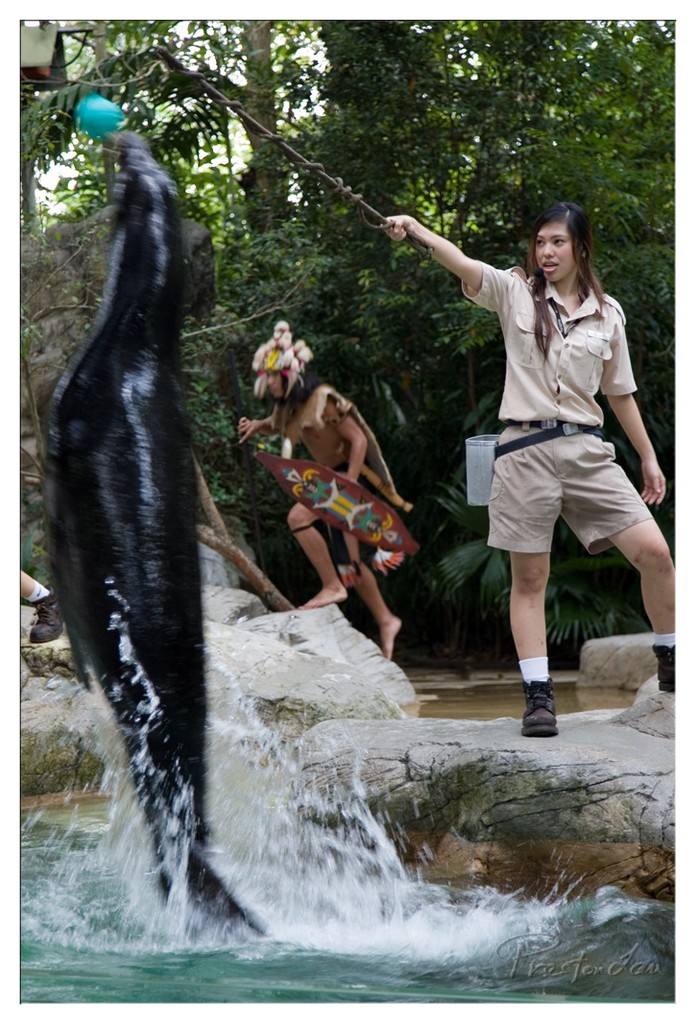

1. Overall Rating (0–10) — 6.8
This image captures a dynamic moment during a marine animal performance, where the energy of a leaping sea lion and the poised stance of a trainer create a sense of motion and interaction. The lush green backdrop and naturalistic setting lend authenticity to the scene, while the presence of a costumed performer adds an element of theatrical storytelling. While the composition and lighting are strong, the overall impact is slightly diminished by a lack of visual cohesion between the foreground action and the background elements.
2. Composition (0–10) — 6.5
The sea lion’s vertical leap dominates the left side, creating a strong diagonal that draws the eye, while the trainer’s extended arm reinforces the interaction. However, the background figure in costume appears disconnected, slightly cluttering the frame and distracting from the central action.
3. Lighting (0–10) — 7.0
Natural, diffused daylight illuminates the scene evenly, highlighting the water spray and the wet texture of the sea lion’s fur. The soft light enhances the mood without creating harsh shadows, though the overcast quality slightly flattens the depth.
4. Color & Tone (0–10) — 6.8
The palette is dominated by earthy greens and browns, with the black of the sea lion providing strong contrast. The teal of the ball adds a pop of color, though the overall tone leans slightly muted, reducing the vibrancy of the scene.
5. Creativity (0–10) — 7.0
The blend of animal performance, human interaction, and cultural costume creates a layered narrative that feels both playful and staged. The inclusion of the costumed figure suggests a thematic performance, adding depth beyond a standard animal show.
6. Technical Quality (0–10) — 7.5
The image is sharp in the key areas—particularly the sea lion and trainer—with clear focus on the main action. The water spray is captured with good motion blur, conveying movement. The watermark is unobtrusive and does not detract from the composition.
7. Emotional Impact (0–10) — 6.5
The image evokes a sense of wonder and entertainment, particularly through the sea lion’s acrobatic leap. However, the emotional connection is tempered by the somewhat staged quality and the slight visual dissonance between the naturalistic and theatrical elements.
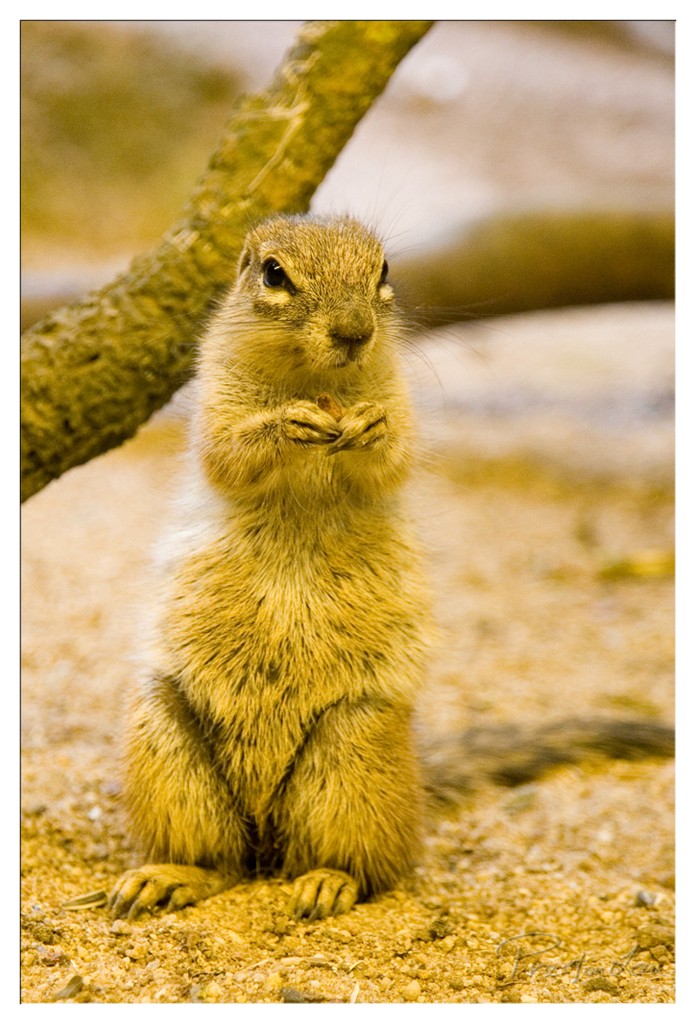

1. Overall Rating (0–10) — 7.5
This photograph captures a charming moment of a ground squirrel in a naturalistic pose, its paws clasped as if in quiet contemplation. The warm, golden tone enhances the animal’s soft fur and evokes a sense of sunlit stillness, while the shallow depth of field isolates the subject with gentle intimacy. Though the image feels slightly over-processed in its color grading, the emotional connection to the creature remains strong, making it both endearing and visually engaging.
2. Composition (0–10) — 7.0
The squirrel is centered and well-framed, with the diagonal branch adding a subtle leading line that guides the eye toward the subject. The shallow depth of field effectively isolates the animal, though the background remains just detailed enough to suggest context without distraction.
3. Lighting (0–10) — 7.5
Soft, diffused light illuminates the squirrel evenly, highlighting the texture of its fur without harsh shadows. The warm lighting enhances the scene’s natural glow, suggesting late afternoon sun and contributing to the photo’s cozy atmosphere.
4. Color & Tone (0–10) — 7.0
A warm, yellow-ochre palette dominates, giving the image a vintage, sun-drenched quality. While the color temperature is harmonious and evocative, the saturation feels slightly boosted, causing a loss of subtle tonal variation in the fur and background.
5. Creativity (0–10) — 7.5
The anthropomorphic posture of the squirrel—standing upright with paws together—adds a whimsical, narrative quality. The choice to emphasize the creature’s expressive stillness transforms a simple wildlife moment into a character-driven vignette.
6. Technical Quality (0–10) — 8.0
Sharp focus on the squirrel’s face and front body, with a clean bokeh background, demonstrates strong technical execution. The image is free of noise and artifacts, with a well-managed depth of field.
7. Emotional Impact (0–10) — 8.0
The photograph elicits warmth and affection, drawing the viewer into a quiet, intimate moment with the animal. Its human-like posture and direct gaze create a sense of connection, making it both charming and memorable.
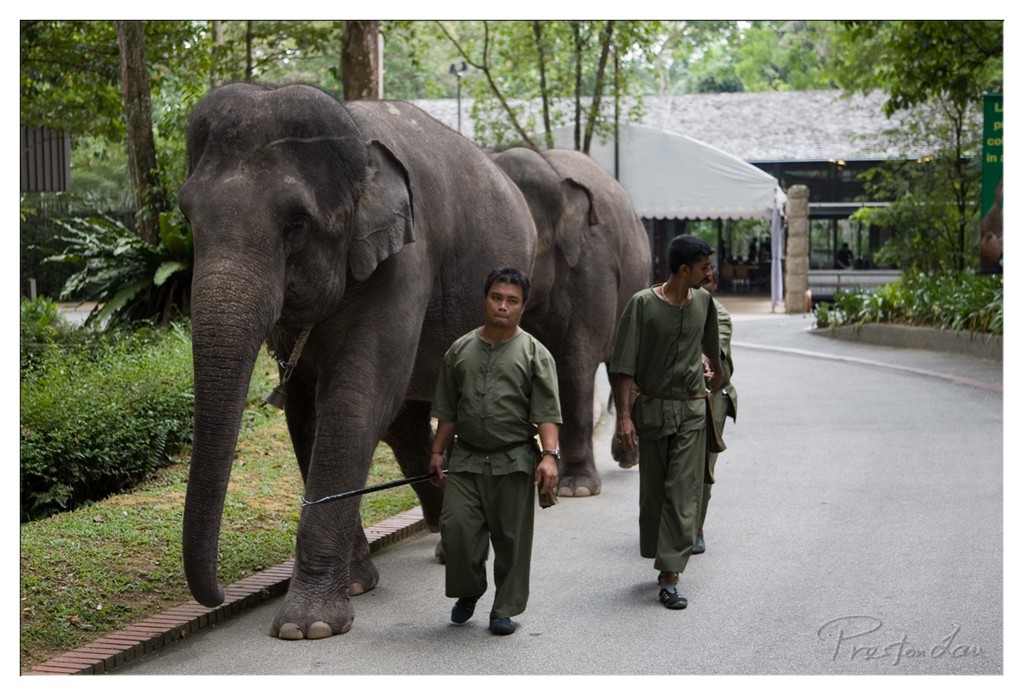

1. Overall Rating (0–10) — 7.0
This photograph captures a quiet, intimate moment of human-animal companionship within a lush, naturalistic setting. The presence of the elephants and their handlers conveys a sense of routine and trust, while the soft, diffused lighting enhances the calm atmosphere. Though the composition is grounded and observational, it lacks a compelling focal point, and the background details slightly distract from the central narrative.
2. Composition (0–10) — 6.0
The diagonal path and leading lines guide the eye toward the subjects, but the off-center placement of the lead elephant and the two handlers creates a slightly uneven balance. The depth of field is effective, but the background elements—particularly the building and signage—compete for attention.
3. Lighting (0–10) — 7.0
The soft, overcast lighting evenly illuminates the scene, minimizing harsh shadows and allowing for rich textural detail in the elephant’s skin and the handlers’ clothing. The diffused light contributes to the serene mood, though it slightly flattens the image’s dynamic range.
4. Color & Tone (0–10) — 6.5
The palette is dominated by earthy greens and grays, creating a natural, harmonious tone. While the colors are subdued, they suit the setting well, though a touch more vibrancy in the foliage could add visual energy.
5. Creativity (0–10) — 7.0
The image offers a candid glimpse into a daily moment, elevating it beyond mere documentation. The choice to capture the elephants in motion with their handlers provides a narrative quality, and the inclusion of the signature adds a personal touch.
6. Technical Quality (0–10) — 7.5
The focus is sharp on the main subjects, and the exposure is well-balanced. The image is clean and free of noticeable artifacts, with a good level of detail throughout the frame.
7. Emotional Impact (0–10) — 7.5
The photograph evokes a sense of quiet dignity and connection, inviting the viewer to reflect on the relationship between humans and animals. The subtle expressions and body language of the handlers convey a deep familiarity with their charges, fostering a quiet emotional resonance.
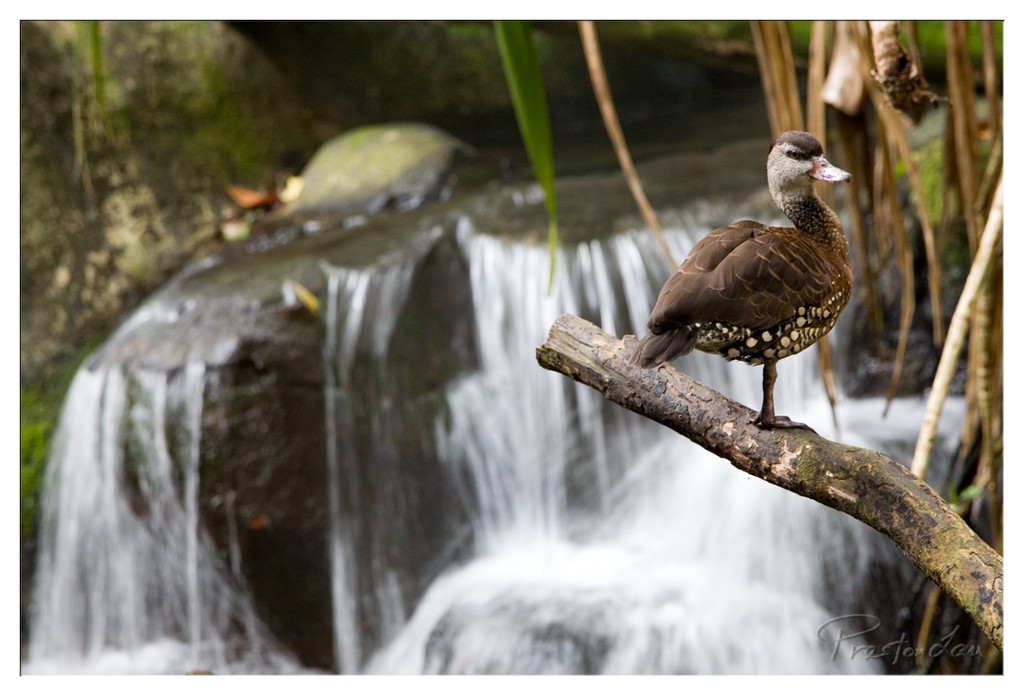

1. Overall Rating (0–10) — 7.5
This photograph captures a serene moment in nature, where a duck perches calmly on a branch against the soft, flowing motion of a waterfall. The contrast between the stillness of the bird and the gentle blur of moving water creates a tranquil, almost meditative mood. While the image is rich in atmosphere and composition, the lighting and color palette could be more dynamic to fully elevate its visual impact.
2. Composition (0–10) — 8.0
The duck is well-placed on the diagonal branch, leading the eye naturally into the frame, while the waterfall provides a soft, textured backdrop. The use of depth of field effectively isolates the subject, creating a balanced and harmonious arrangement.
3. Lighting (0–10) — 6.5
Natural, diffused light softly illuminates the scene, enhancing the duck’s details without harsh shadows. However, the light lacks warmth, contributing to a slightly flat and muted atmosphere.
4. Color & Tone (0–10) — 7.0
The palette is grounded in earthy browns and soft greens, complemented by the white of the waterfall. While cohesive, the colors lean toward neutrality, missing a vibrant pop that could heighten visual engagement.
5. Creativity (0–10) — 7.5
The photographer captures a quiet, intimate wildlife moment with thoughtful composition and a sense of narrative. The choice to emphasize motion through a slow shutter adds artistic depth, transforming a simple scene into a contemplative image.
6. Technical Quality (0–10) — 8.0
Sharp focus on the duck, with smooth bokeh in the background, demonstrates strong technical control. The long exposure renders the water beautifully, and the image is free of noise or technical flaws.
7. Emotional Impact (0–10) — 7.0
The image evokes calm and stillness, inviting the viewer to pause and reflect. The duck’s composed presence against the flowing water creates a subtle emotional resonance, suggesting peace and quiet endurance.
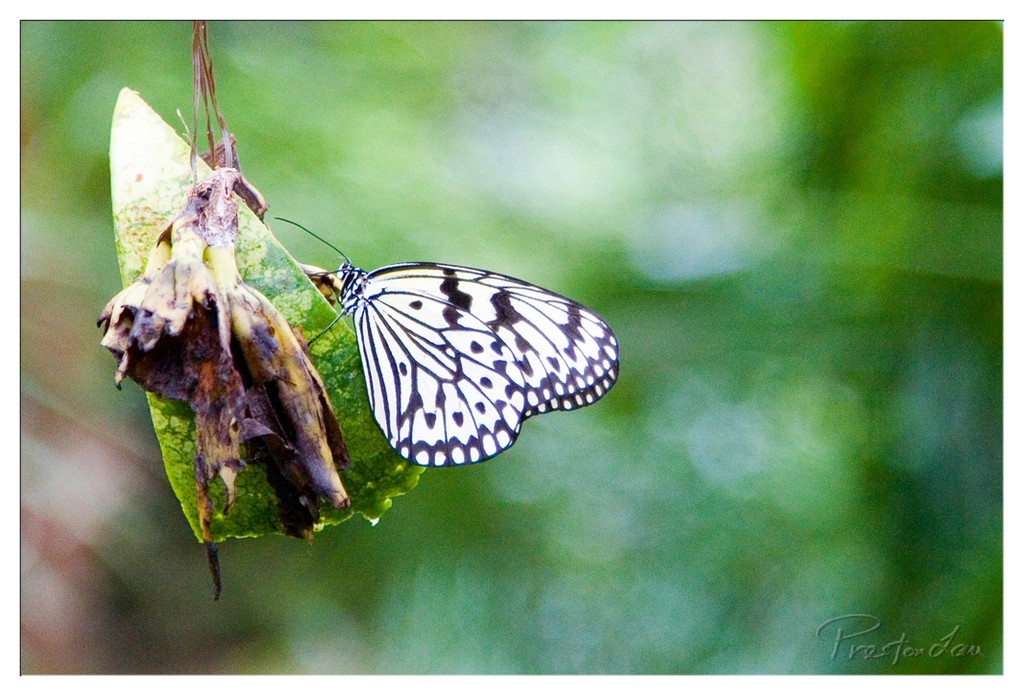

1. Overall Rating (0–10) — 7.5
This photograph captures a delicate moment of stillness in nature, where the intricate pattern of the butterfly’s wings contrasts beautifully with the soft decay of the leaf. The shallow depth of field isolates the subject with poetic grace, drawing attention to the fragile beauty of both the living and the decaying. While the image is visually striking and emotionally resonant, a slightly more intentional composition could elevate its narrative impact.
2. Composition (0–10) — 7.0
The butterfly is positioned slightly off-center, creating a dynamic balance with the decaying leaf on the left. The diagonal line of the leaf adds visual interest, though the composition feels slightly asymmetrical and could benefit from tighter framing to emphasize the subject’s interaction with the leaf.
3. Lighting (0–10) — 7.5
Natural, diffused light softly illuminates the butterfly, highlighting the texture of its wings without harsh shadows. The soft glow enhances the organic feel of the scene and contributes to the serene mood.
4. Color & Tone (0–10) — 8.0
The palette is rich with varying shades of green, punctuated by the bold black-and-white pattern of the butterfly. The contrast between the fresh green and the browned leaf adds depth and symbolic resonance, while the overall tonal harmony is pleasing and cohesive.
5. Creativity (0–10) — 8.0
The juxtaposition of life and decay is powerfully conveyed through the butterfly resting on a withered leaf, suggesting themes of transformation and continuity. The choice to focus on this quiet moment reflects a thoughtful, contemplative vision.
6. Technical Quality (0–10) — 8.5
The focus is sharp on the butterfly’s wings, while the background dissolves into a smooth bokeh. The image is clean, well-exposed, and shows excellent control over depth of field, showcasing strong technical execution.
7. Emotional Impact (0–10) — 8.0
There is a quiet melancholy and beauty in the scene—evoking a sense of fragility, renewal, and the passage of time. The viewer is invited to reflect on the cycle of life, making the image emotionally engaging and thought-provoking.
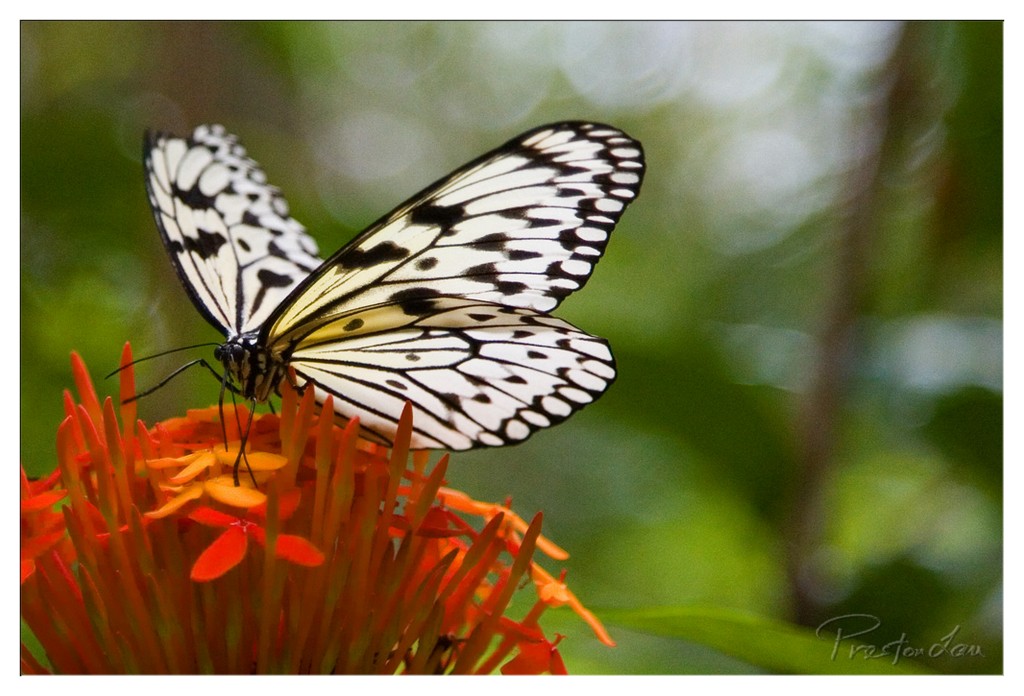

1. Overall Rating (0–10) — 8.0
This photograph captures a moment of delicate beauty, where the intricate pattern of the butterfly’s wings contrasts vividly with the saturated orange of the flower. The shallow depth of field isolates the subject with a painterly softness, enhancing the sense of stillness and grace. While the composition is strong and the subject compelling, the overall mood, though serene, could benefit from a slightly more dynamic lighting treatment to deepen the emotional resonance.
2. Composition (0–10) — 8.0
The butterfly is placed slightly off-center, following the rule of thirds, with its wings spread diagonally to guide the eye across the frame. The blurred green background creates a natural vignette, drawing attention to the subject, while the flower’s radial structure provides a strong visual anchor.
3. Lighting (0–10) — 7.5
The light is soft and diffused, evenly illuminating the butterfly’s wings without harsh shadows, which preserves the fine details of the pattern. The subtle highlights on the wings enhance their translucency, while the background retains a gentle glow that adds depth.
4. Color & Tone (0–10) — 8.5
The contrast between the bold orange of the flower and the high-contrast black-and-white wings creates a striking visual harmony. The warm tones of the bloom are balanced by the cool green backdrop, producing a rich, natural palette that feels both vibrant and cohesive.
5. Creativity (0–10) — 8.0
The image demonstrates a thoughtful approach to macro nature photography, emphasizing form and pattern over mere documentation. The choice of a shallow depth of field and the careful framing elevate the scene from a simple snapshot to an intimate, almost meditative portrait of the butterfly.
6. Technical Quality (0–10) — 8.5
Sharp focus on the butterfly’s body and wings ensures clarity in the intricate patterns, while the background remains smoothly blurred. The exposure is well-balanced, with no blown-out highlights or lost shadows, and the watermark is discreetly placed.
7. Emotional Impact (0–10) — 7.5
The photograph evokes a sense of tranquility and wonder, inviting the viewer to pause and appreciate the delicate intricacies of nature. The stillness of the moment and the beauty of the butterfly’s form create a quiet emotional connection, though the lack of motion or narrative leaves room for deeper interpretation.
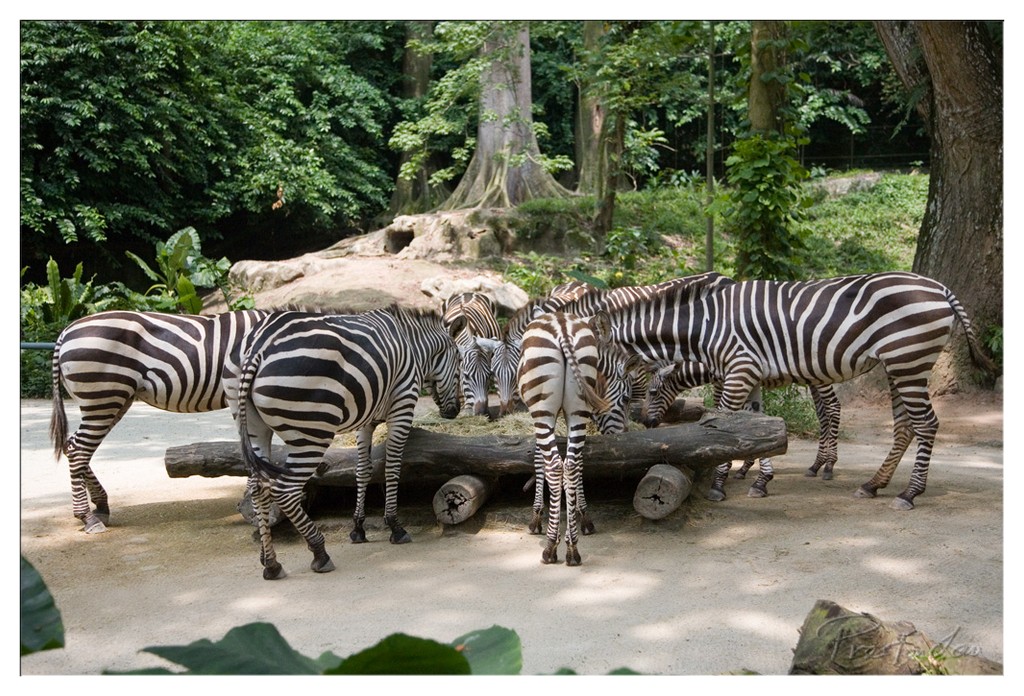

1. Overall Rating (0–10) — 7.0
This photograph captures a serene moment of zebras gathered around a feeding log in a lush, naturalistic enclosure, evoking a sense of calm coexistence with nature. The strong contrast of the zebras’ stripes against the green foliage creates visual interest, while the dappled sunlight adds depth and atmosphere. While the image is well-composed and rich in detail, its emotional resonance is slightly restrained by a lack of dynamic interaction among the animals.
2. Composition (0–10) — 7.0
The zebras are arranged along a diagonal line, leading the eye across the frame and creating a sense of movement. The use of the log as a natural focal point grounds the composition, while the surrounding foliage frames the scene effectively. A slightly tighter crop could enhance focus on the animals, but the current framing successfully captures the environment.
3. Lighting (0–10) — 7.5
Natural daylight filters through the trees, casting soft, dappled shadows that enhance texture and depth. The lighting is balanced and even, highlighting the zebras’ distinctive patterns without harsh glare. The interplay of light and shade adds a painterly quality to the scene.
4. Color & Tone (0–10) — 7.0
The palette is rich with earthy greens and browns, complemented by the high-contrast black-and-white stripes of the zebras. The colors feel natural and harmonious, with a subtle warmth that enhances the tranquil mood. A touch more saturation could make the greens more vibrant, but the tonal balance is well handled.
5. Creativity (0–10) — 6.5
The image captures a familiar zoo scene with a documentary-like clarity, emphasizing realism over artistic interpretation. While the subject is inherently compelling, the composition and framing remain conventional, offering little surprise or narrative innovation.
6. Technical Quality (0–10) — 8.0
The image is sharp and detailed, with clear focus on the zebras and a well-defined depth of field. The exposure is accurate, and the noise level is low, indicating strong technical execution. The watermark is discreet and does not detract from the image.
7. Emotional Impact (0–10) — 6.5
The photograph conveys a quiet, contemplative mood, inviting viewers to reflect on the animals’ behavior in a managed natural habitat. The stillness of the scene allows for a moment of connection, though the lack of dramatic action or close-up intimacy limits its emotional punch.
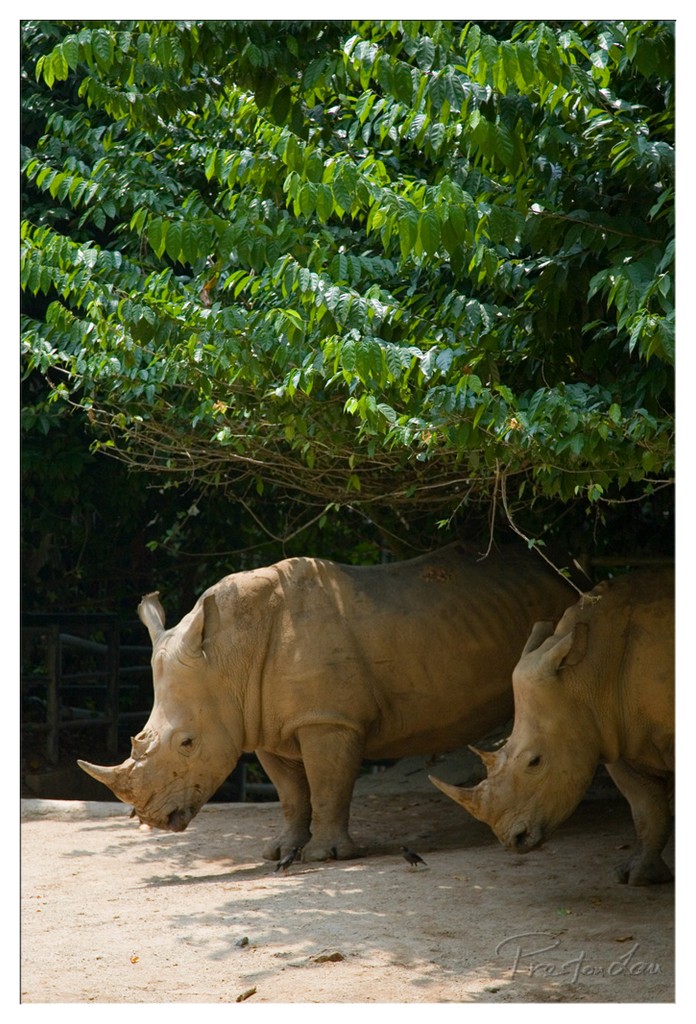

1. Overall Rating (0–10) — 7.0
This photograph captures a serene moment between two rhinoceroses beneath a lush canopy, evoking a sense of calm coexistence in a naturalistic setting. The interplay of light and shadow through the leaves adds depth and texture, while the animals’ quiet posture suggests a peaceful, unhurried rhythm. While the composition is strong and the mood contemplative, a more dynamic angle or tighter framing might elevate the image from documentary to poetic.
2. Composition (0–10) — 7.0
The rhinos are placed diagonally across the frame, creating a sense of movement and depth. The overhanging foliage frames the top of the image beautifully, while the open foreground grounds the subjects, though the left side feels slightly empty.
3. Lighting (0–10) — 7.5
Dappled sunlight filters through the canopy, casting soft, natural shadows that highlight the rhinos’ textured skin and add dimension to the scene. The lighting enhances the tranquil mood and gives the image a gentle, organic feel.
4. Color & Tone (0–10) — 7.0
The palette is dominated by earthy browns and vibrant greens, creating a harmonious natural contrast. The tones are well-balanced, with subtle warmth in the light enhancing the organic atmosphere without overpowering the scene.
5. Creativity (0–10) — 6.5
The image presents a familiar subject with a calm, observational approach. While it captures a quiet beauty, it leans more toward documentation than conceptual or emotional storytelling, offering a grounded realism rather than a bold artistic statement.
6. Technical Quality (0–10) — 8.0
The focus is sharp on the rhinos, with clear detail in their skin and the surrounding foliage. The exposure is well-managed, and the image is free of distracting artifacts, demonstrating solid technical execution.
7. Emotional Impact (0–10) — 7.0
The quiet presence of the rhinos and the gentle light evoke a sense of reverence for nature and its creatures. The viewer is invited to pause and reflect, creating a subtle but meaningful emotional connection to the moment.
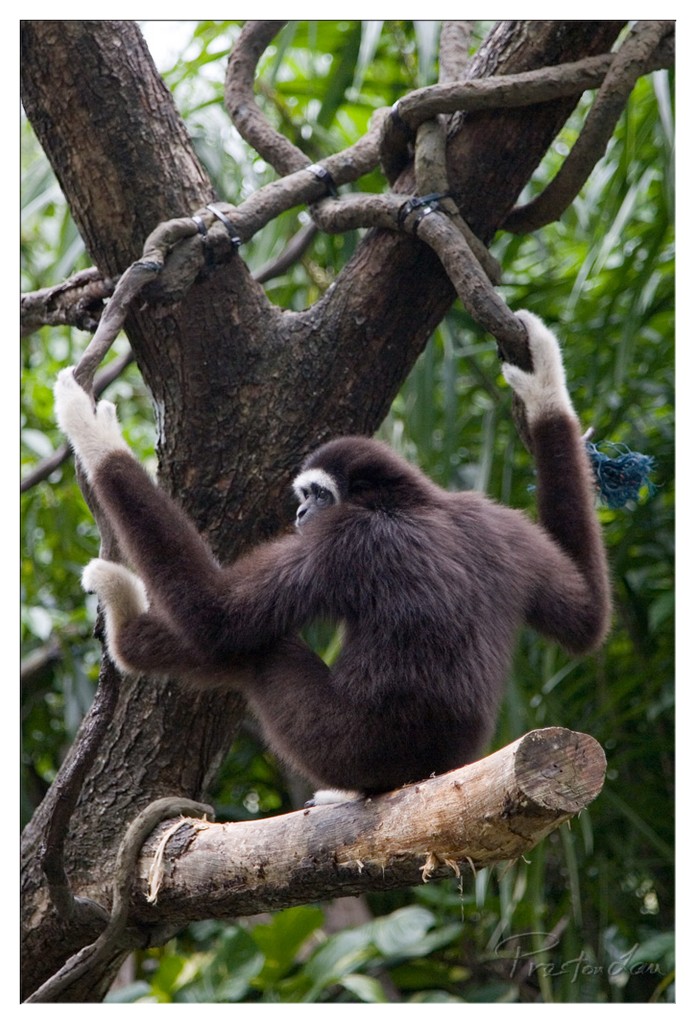

1. Overall Rating (0–10) — 7.5
This photograph captures a gibbon in a moment of graceful motion, its limbs extended like a living sculpture against a lush, verdant backdrop. The animal’s expressive posture and the interplay of light and shadow lend a sense of quiet dynamism, while the natural setting enhances the feeling of wildness. The image is strong in its narrative and presence, though the slightly overexposed highlights and soft background slightly diminish its visual polish.
2. Composition (0–10) — 7.0
The gibbon is well-placed in the frame, with its outstretched arms creating strong diagonal lines that guide the eye. The inclusion of the tree trunk and branches adds depth and context, though the composition feels slightly unbalanced due to the heavy left-side presence of the trunk.
3. Lighting (0–10) — 6.5
Natural, diffused light highlights the gibbon’s form, but the background foliage is slightly overexposed, losing detail in the highlights. The lighting creates a soft, ambient mood but lacks dramatic contrast.
4. Color & Tone (0–10) — 7.0
The image features a rich, natural palette dominated by deep browns and vibrant greens, with the gibbon’s white hands and face providing a striking contrast. The color balance is pleasing, though some saturation appears slightly muted in the foliage.
5. Creativity (0–10) — 7.5
The photograph captures a rare moment of animal grace and intelligence, transforming a simple wildlife scene into a compelling visual story. The framing and timing reflect thoughtful observation, elevating the image beyond mere documentation.
6. Technical Quality (0–10) — 7.5
The focus is sharp on the gibbon, and the image is free of noticeable noise. The depth of field effectively isolates the subject, though the background blur is not perfectly smooth.
7. Emotional Impact (0–10) — 8.0
The image evokes a sense of wonder and connection with nature, drawing the viewer into the gibbon’s world. Its expressive posture and natural environment create a quiet emotional resonance, inviting reflection on wildlife and movement.
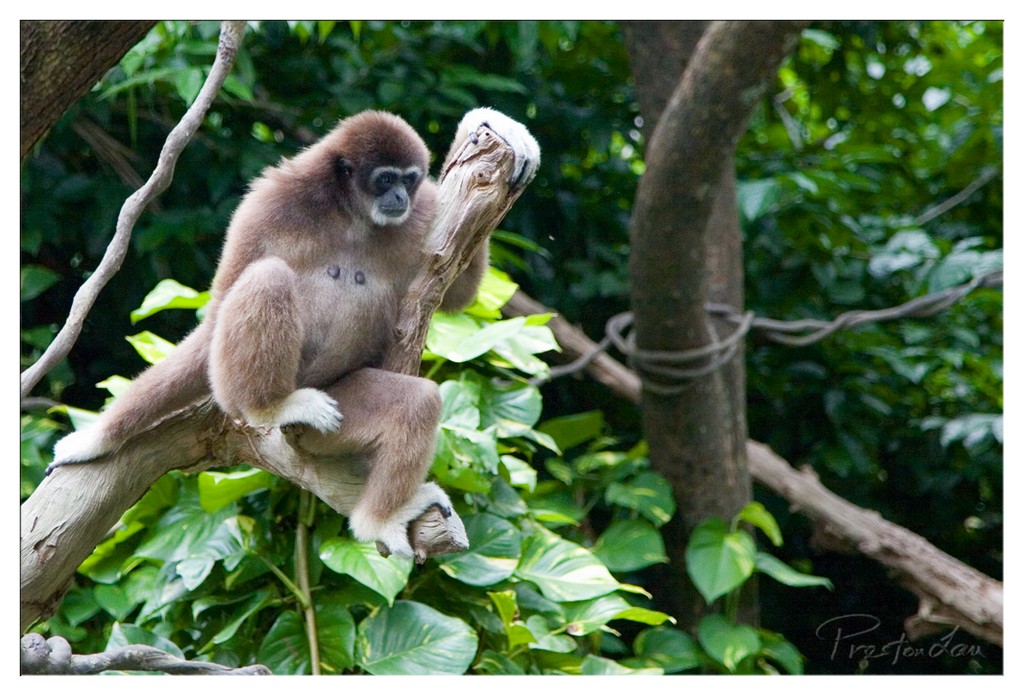

1. Overall Rating (0–10) — 7.0
This photograph captures a gibbon in a moment of quiet repose, its fur and surroundings rendered with natural clarity and gentle warmth. The subject’s contemplative pose and the lush greenery create a serene, almost meditative atmosphere. While the image is visually engaging and well-composed, it lacks a stronger emotional hook or dynamic tension, holding back from true artistic distinction.
2. Composition (0–10) — 7.5
The gibbon is centered slightly to the left, creating a balanced and natural framing that draws attention to the subject. The diagonal branch and surrounding foliage guide the eye through the image, while the depth of field effectively isolates the animal from the background.
3. Lighting (0–10) — 7.0
Soft, diffused natural light illuminates the scene evenly, highlighting the texture of the gibbon’s fur without harsh shadows. The lighting enhances the sense of calm and contributes to the peaceful mood of the image.
4. Color & Tone (0–10) — 7.5
The rich, verdant greens of the foliage contrast beautifully with the warm brown tones of the gibbon’s fur, creating a harmonious and vibrant palette. The colors feel natural and well-balanced, with subtle tonal variation adding depth.
5. Creativity (0–10) — 6.5
The image captures a quiet, observational moment in nature, but its approach is more documentary than expressive. While the subject and setting are compelling, the photograph doesn’t push beyond the familiar to offer a unique perspective.
6. Technical Quality (0–10) — 8.0
The image is sharp and well-focused, with excellent detail in both the subject and background foliage. The depth of field is controlled effectively, and the exposure is clean, with no visible noise or artifacts.
7. Emotional Impact (0–10) — 6.5
The gibbon’s stillness evokes a sense of quiet contemplation, inviting the viewer to pause and reflect. While the emotional resonance is gentle and pleasant, it remains subtle, leaving room for deeper connection.
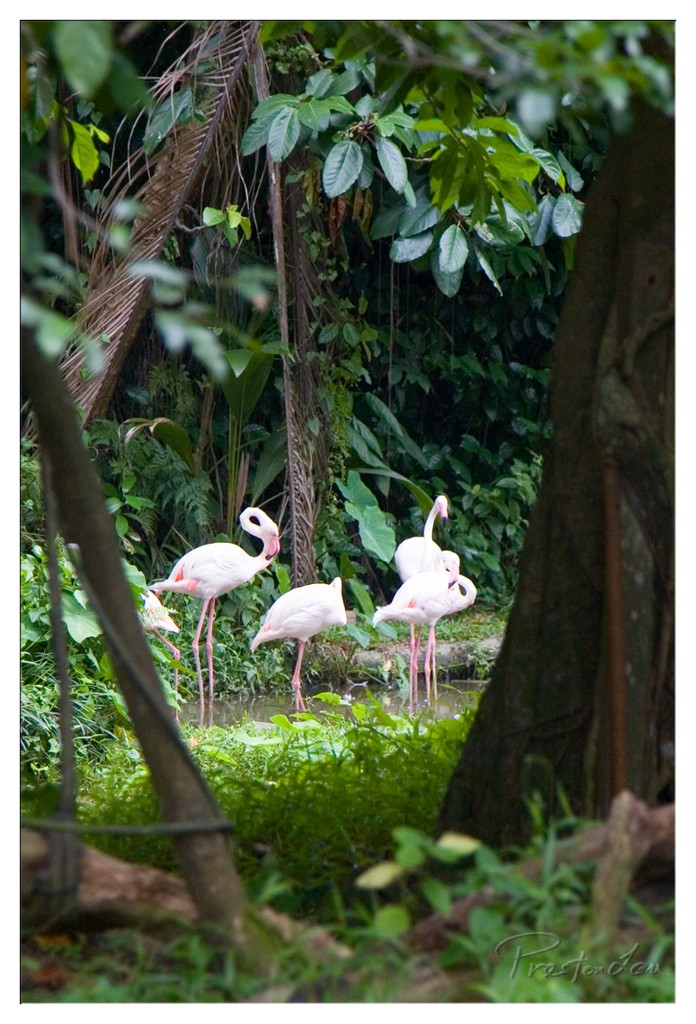

1. Overall Rating (0–10) — 7.0
This photograph captures a serene moment in a lush, tropical setting, where the elegant pink flamingos stand in quiet contrast to the dense greenery. The framing through the foliage creates a sense of discovery, as if the viewer is peeking into a secluded natural sanctuary. While the image is visually pleasing and evocative of calm, the soft focus and slightly muted colors hold it back from greater impact.
2. Composition (0–10) — 7.5
The use of foreground elements—tree trunks and leaves—creates a natural frame, drawing the eye toward the flamingos at the center. The placement of the birds across the midground provides balance and visual rhythm, though the scattered arrangement could benefit from tighter grouping.
3. Lighting (0–10) — 6.5
Diffused, soft light filters through the canopy, creating a gentle glow that enhances the tranquil mood. However, the lack of strong directional light results in a somewhat flat appearance, with limited highlights and shadows to add depth.
4. Color & Tone (0–10) — 7.0
The rich greens of the foliage contrast beautifully with the soft pinks of the flamingos, creating a harmonious and natural palette. The tones are well-balanced, though slightly desaturated, giving the image a muted, dreamlike quality.
5. Creativity (0–10) — 7.5
The photographer's choice to shoot through the foliage adds a layer of narrative, suggesting a hidden, untouched world. The interplay between the vibrant birds and the subdued environment demonstrates a thoughtful approach to storytelling.
6. Technical Quality (0–10) — 7.0
The image is sharp in the midground where the flamingos are located, though some foreground elements are slightly soft. The focus is adequate, and the exposure is well-managed, with no significant over- or underexposed areas.
7. Emotional Impact (0–10) — 7.0
The image evokes a sense of peace and wonder, inviting the viewer to pause and appreciate the quiet beauty of nature. The flamingos’ graceful forms and the lush surroundings stir a feeling of calm and connection to the natural world.
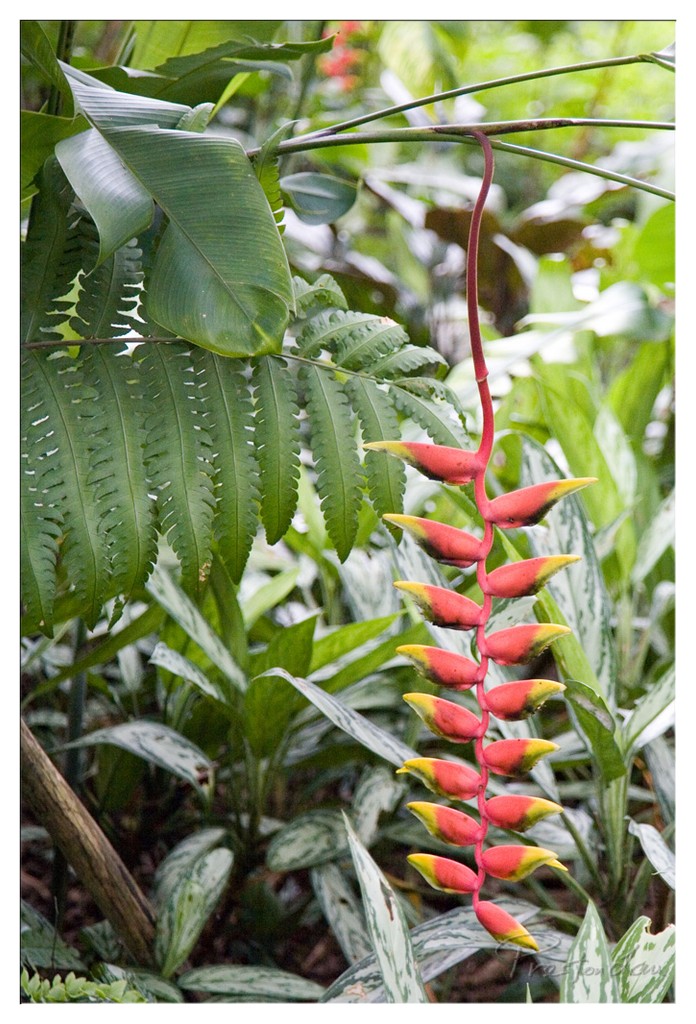

1. Overall Rating (0–10) — 7.5
This photograph captures the vibrant life of a tropical garden, where the bold, cascading heliconia flower takes center stage against a lush, verdant backdrop. The vivid red and yellow hues of the bloom contrast beautifully with the deep greens of the surrounding foliage, creating a rich, natural tapestry that feels both exotic and serene. While the image is visually striking, the composition’s density slightly reduces the flower’s dramatic impact, and the soft focus in the background, though atmospheric, could be more deliberate to guide the eye.
2. Composition (0–10) — 6.5
The heliconia flower is well-placed along a diagonal axis, drawing the eye from the upper left to the lower right, but the surrounding foliage creates visual clutter that competes for attention. A tighter crop or more intentional negative space would enhance the subject’s prominence.
3. Lighting (0–10) — 7.0
Soft, diffused light illuminates the scene evenly, preserving detail in both the flower and the leaves without harsh shadows. The light enhances the natural saturation of the colors, contributing to the image’s lush, tropical feel.
4. Color & Tone (0–10) — 8.0
The palette is rich and harmonious, with the fiery reds and yellows of the heliconia standing out against the cool greens and subtle variegation of the surrounding plants. The tonal range is well-balanced, with enough contrast to make the subject pop without appearing overexposed.
5. Creativity (0–10) — 7.0
The image successfully captures the beauty of a tropical ecosystem with a naturalistic approach. While not overtly experimental, the choice to highlight the heliconia’s elegant form within its environment demonstrates a strong sense of botanical appreciation and visual storytelling.
6. Technical Quality (0–10) — 8.0
The photograph is sharp and detailed, particularly in the foreground where the flower and adjacent leaves are in focus. The depth of field is appropriately managed, though the background’s softness could be more refined to prevent visual distraction.
7. Emotional Impact (0–10) — 7.5
The image evokes a sense of tranquility and wonder, inviting the viewer into a quiet corner of a lush jungle. The vibrant colors and organic forms create a calming yet stimulating experience, suggesting the beauty of untouched nature.
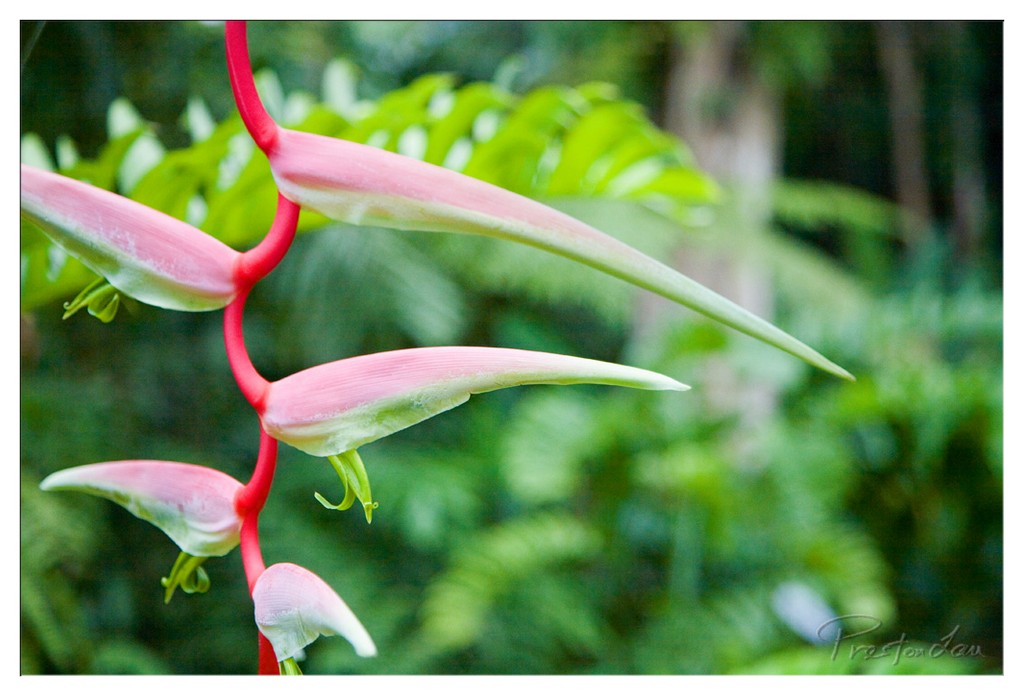

1. Overall Rating (0–10) — 7.5
This image captures the elegant curvature and vibrant contrast of a heliconia flower, transforming a lush tropical setting into a moment of quiet botanical beauty. The soft focus background enhances the subject’s delicate form, while the interplay of pink and green evokes a sense of serene vitality. Though the composition is strong, the image could benefit from more dynamic lighting to heighten the flower’s natural drama.
2. Composition (0–10) — 8.0
The diagonal line of the flower stem guides the eye through the frame, creating a graceful rhythm. The subject is well-placed, with negative space on the right providing balance and emphasizing the flower’s elongated shape.
3. Lighting (0–10) — 6.5
Diffused, even lighting softens the tones and preserves detail in the petals, but lacks directional warmth or shadow to add depth. The light feels natural and ambient, enhancing the organic mood but limiting visual contrast.
4. Color & Tone (0–10) — 8.0
The palette is rich and harmonious, with soft pinks and greens creating a natural, calming effect. The vivid red stem provides a striking accent, adding visual interest without disrupting the overall subtlety.
5. Creativity (0–10) — 7.0
The photograph celebrates the quiet elegance of nature with a clear artistic intent—highlighting form, color, and texture. While not overtly experimental, it succeeds in transforming a common tropical plant into a contemplative visual statement.
6. Technical Quality (0–10) — 8.0
Sharp focus on the flower with a smoothly blurred background demonstrates strong control of depth of field. The image is clean, with minimal noise and well-managed detail throughout.
7. Emotional Impact (0–10) — 7.5
The image evokes a sense of tranquility and wonder, inviting the viewer to pause and appreciate the delicate complexity of a single bloom. Its gentle beauty resonates on a quiet, reflective level.
Loading map...